Countrys Gross Domestic Product And Management
VerifiedAdded on 2022/09/18
|23
|4611
|21
AI Summary
Contribute Materials
Your contribution can guide someone’s learning journey. Share your
documents today.
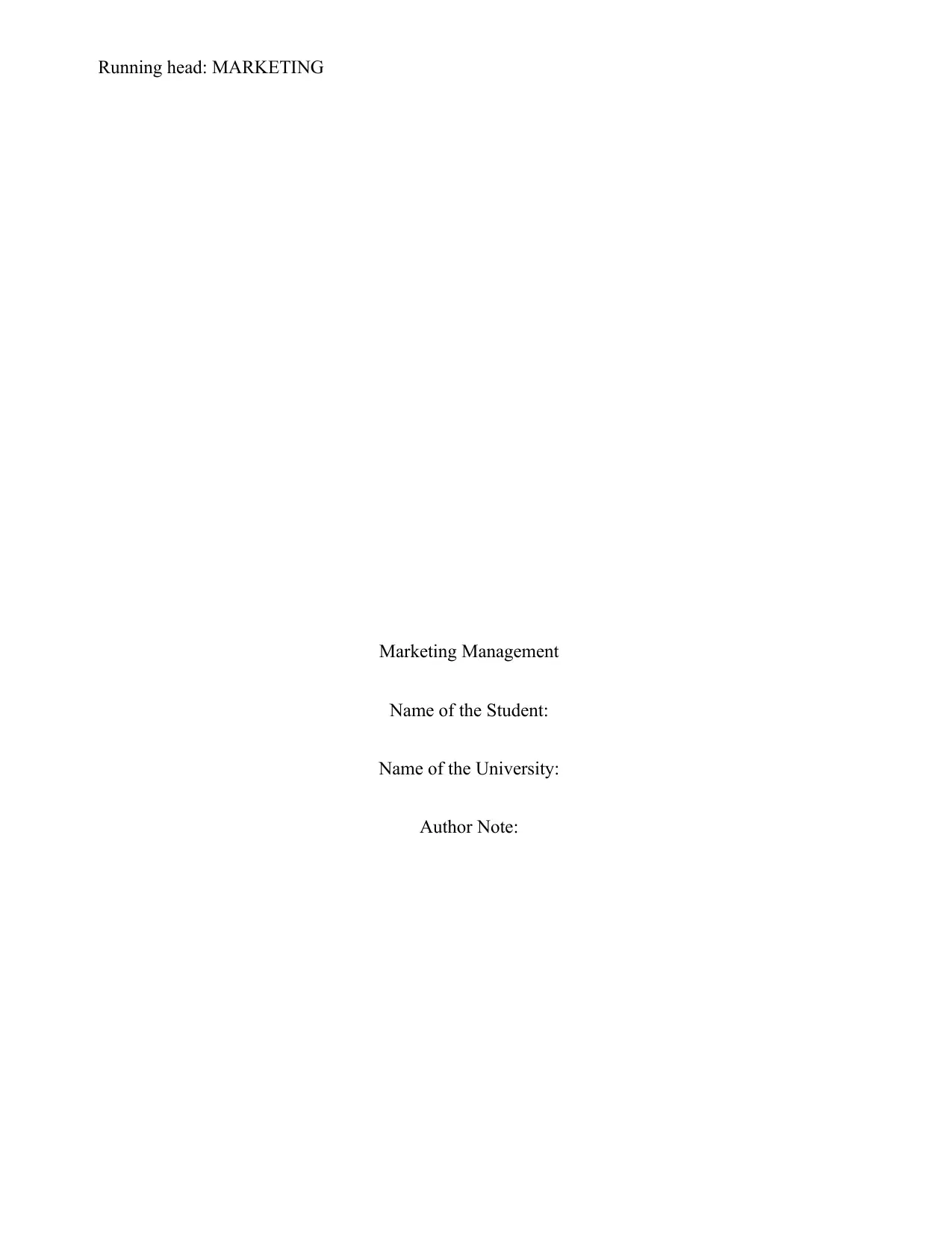
Running head: MARKETING
Marketing Management
Name of the Student:
Name of the University:
Author Note:
Marketing Management
Name of the Student:
Name of the University:
Author Note:
Secure Best Marks with AI Grader
Need help grading? Try our AI Grader for instant feedback on your assignments.
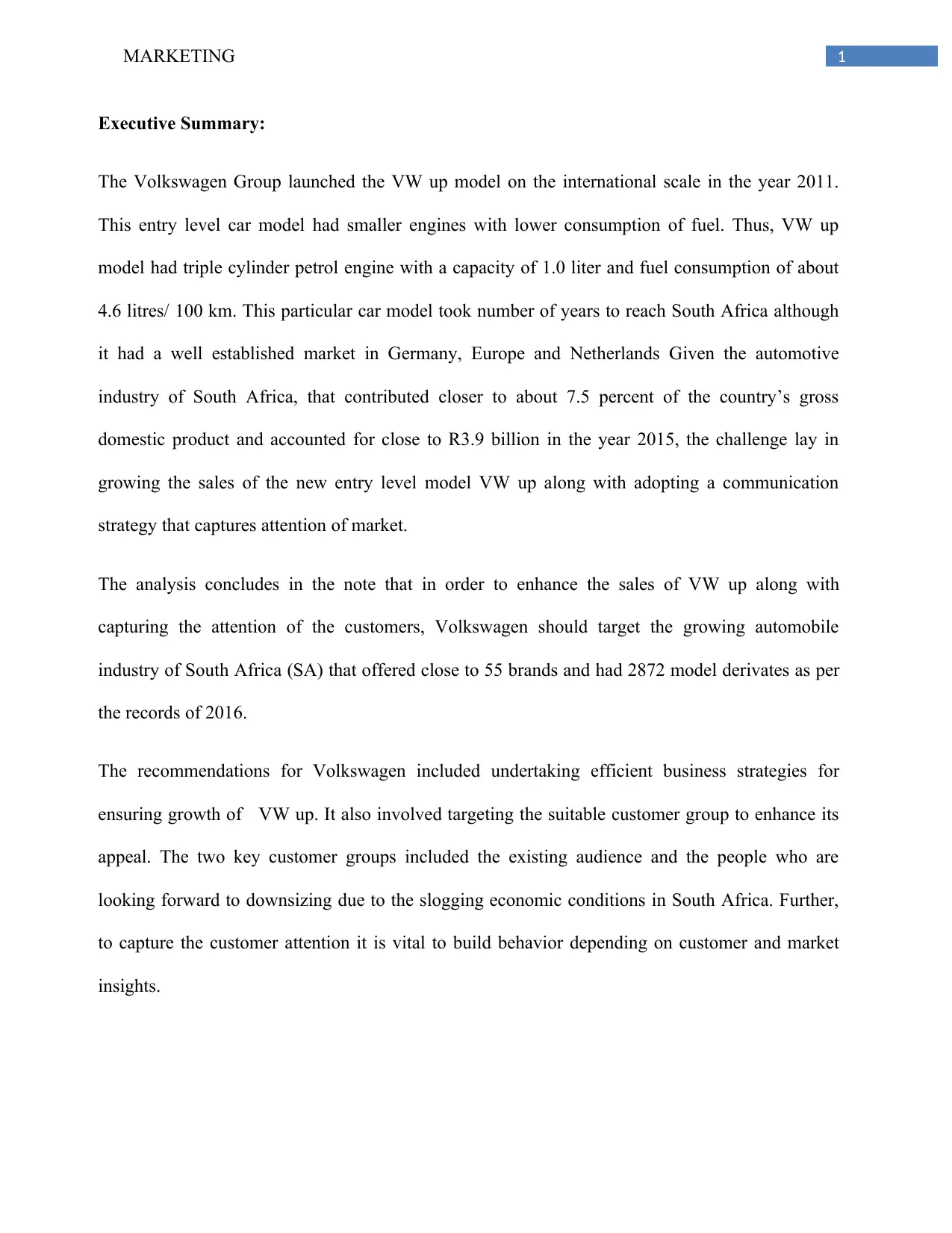
1MARKETING
Executive Summary:
The Volkswagen Group launched the VW up model on the international scale in the year 2011.
This entry level car model had smaller engines with lower consumption of fuel. Thus, VW up
model had triple cylinder petrol engine with a capacity of 1.0 liter and fuel consumption of about
4.6 litres/ 100 km. This particular car model took number of years to reach South Africa although
it had a well established market in Germany, Europe and Netherlands Given the automotive
industry of South Africa, that contributed closer to about 7.5 percent of the country’s gross
domestic product and accounted for close to R3.9 billion in the year 2015, the challenge lay in
growing the sales of the new entry level model VW up along with adopting a communication
strategy that captures attention of market.
The analysis concludes in the note that in order to enhance the sales of VW up along with
capturing the attention of the customers, Volkswagen should target the growing automobile
industry of South Africa (SA) that offered close to 55 brands and had 2872 model derivates as per
the records of 2016.
The recommendations for Volkswagen included undertaking efficient business strategies for
ensuring growth of VW up. It also involved targeting the suitable customer group to enhance its
appeal. The two key customer groups included the existing audience and the people who are
looking forward to downsizing due to the slogging economic conditions in South Africa. Further,
to capture the customer attention it is vital to build behavior depending on customer and market
insights.
Executive Summary:
The Volkswagen Group launched the VW up model on the international scale in the year 2011.
This entry level car model had smaller engines with lower consumption of fuel. Thus, VW up
model had triple cylinder petrol engine with a capacity of 1.0 liter and fuel consumption of about
4.6 litres/ 100 km. This particular car model took number of years to reach South Africa although
it had a well established market in Germany, Europe and Netherlands Given the automotive
industry of South Africa, that contributed closer to about 7.5 percent of the country’s gross
domestic product and accounted for close to R3.9 billion in the year 2015, the challenge lay in
growing the sales of the new entry level model VW up along with adopting a communication
strategy that captures attention of market.
The analysis concludes in the note that in order to enhance the sales of VW up along with
capturing the attention of the customers, Volkswagen should target the growing automobile
industry of South Africa (SA) that offered close to 55 brands and had 2872 model derivates as per
the records of 2016.
The recommendations for Volkswagen included undertaking efficient business strategies for
ensuring growth of VW up. It also involved targeting the suitable customer group to enhance its
appeal. The two key customer groups included the existing audience and the people who are
looking forward to downsizing due to the slogging economic conditions in South Africa. Further,
to capture the customer attention it is vital to build behavior depending on customer and market
insights.
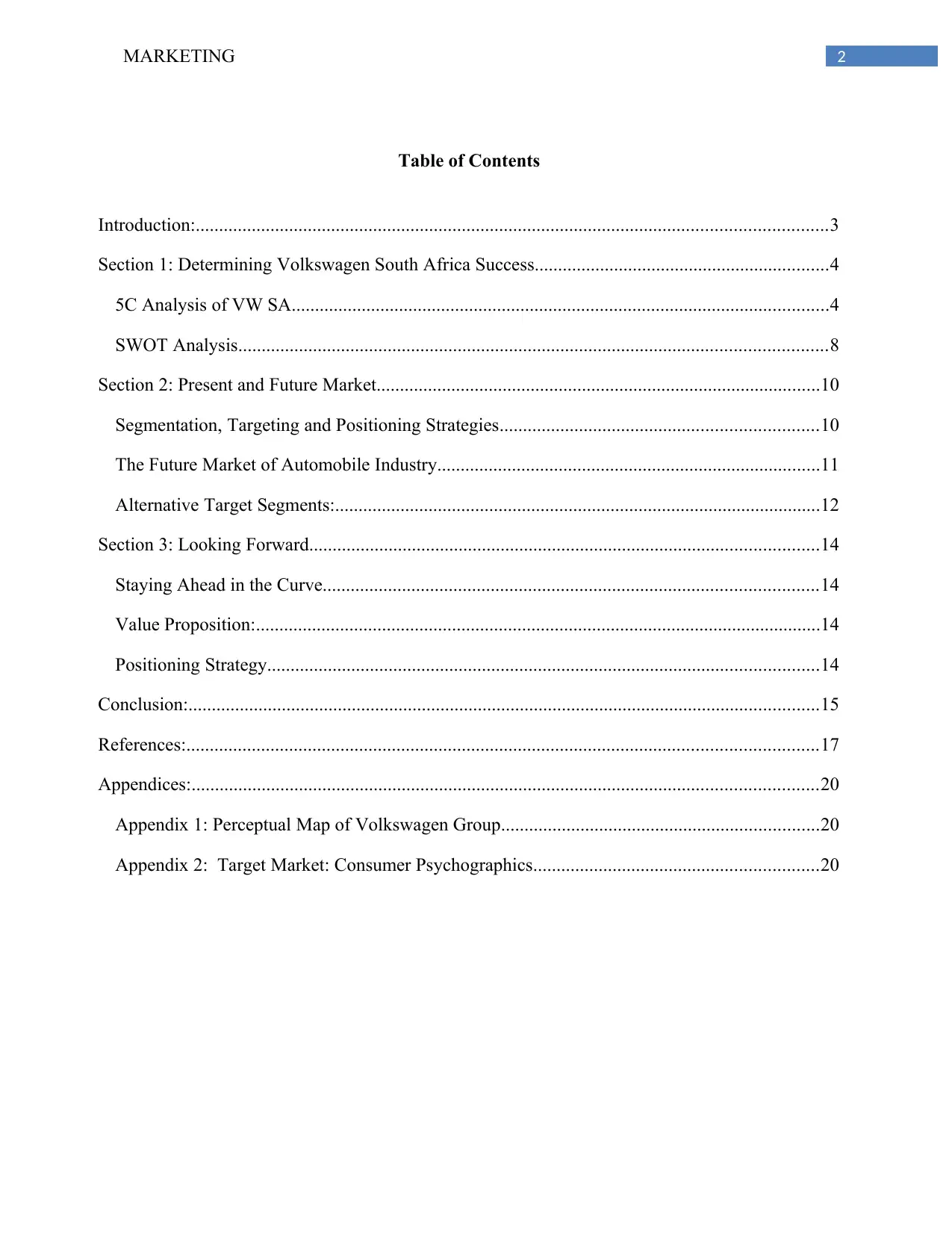
2MARKETING
Table of Contents
Introduction:.......................................................................................................................................3
Section 1: Determining Volkswagen South Africa Success...............................................................4
5C Analysis of VW SA...................................................................................................................4
SWOT Analysis..............................................................................................................................8
Section 2: Present and Future Market...............................................................................................10
Segmentation, Targeting and Positioning Strategies....................................................................10
The Future Market of Automobile Industry..................................................................................11
Alternative Target Segments:........................................................................................................12
Section 3: Looking Forward.............................................................................................................14
Staying Ahead in the Curve..........................................................................................................14
Value Proposition:.........................................................................................................................14
Positioning Strategy......................................................................................................................14
Conclusion:.......................................................................................................................................15
References:.......................................................................................................................................17
Appendices:......................................................................................................................................20
Appendix 1: Perceptual Map of Volkswagen Group....................................................................20
Appendix 2: Target Market: Consumer Psychographics.............................................................20
Table of Contents
Introduction:.......................................................................................................................................3
Section 1: Determining Volkswagen South Africa Success...............................................................4
5C Analysis of VW SA...................................................................................................................4
SWOT Analysis..............................................................................................................................8
Section 2: Present and Future Market...............................................................................................10
Segmentation, Targeting and Positioning Strategies....................................................................10
The Future Market of Automobile Industry..................................................................................11
Alternative Target Segments:........................................................................................................12
Section 3: Looking Forward.............................................................................................................14
Staying Ahead in the Curve..........................................................................................................14
Value Proposition:.........................................................................................................................14
Positioning Strategy......................................................................................................................14
Conclusion:.......................................................................................................................................15
References:.......................................................................................................................................17
Appendices:......................................................................................................................................20
Appendix 1: Perceptual Map of Volkswagen Group....................................................................20
Appendix 2: Target Market: Consumer Psychographics.............................................................20
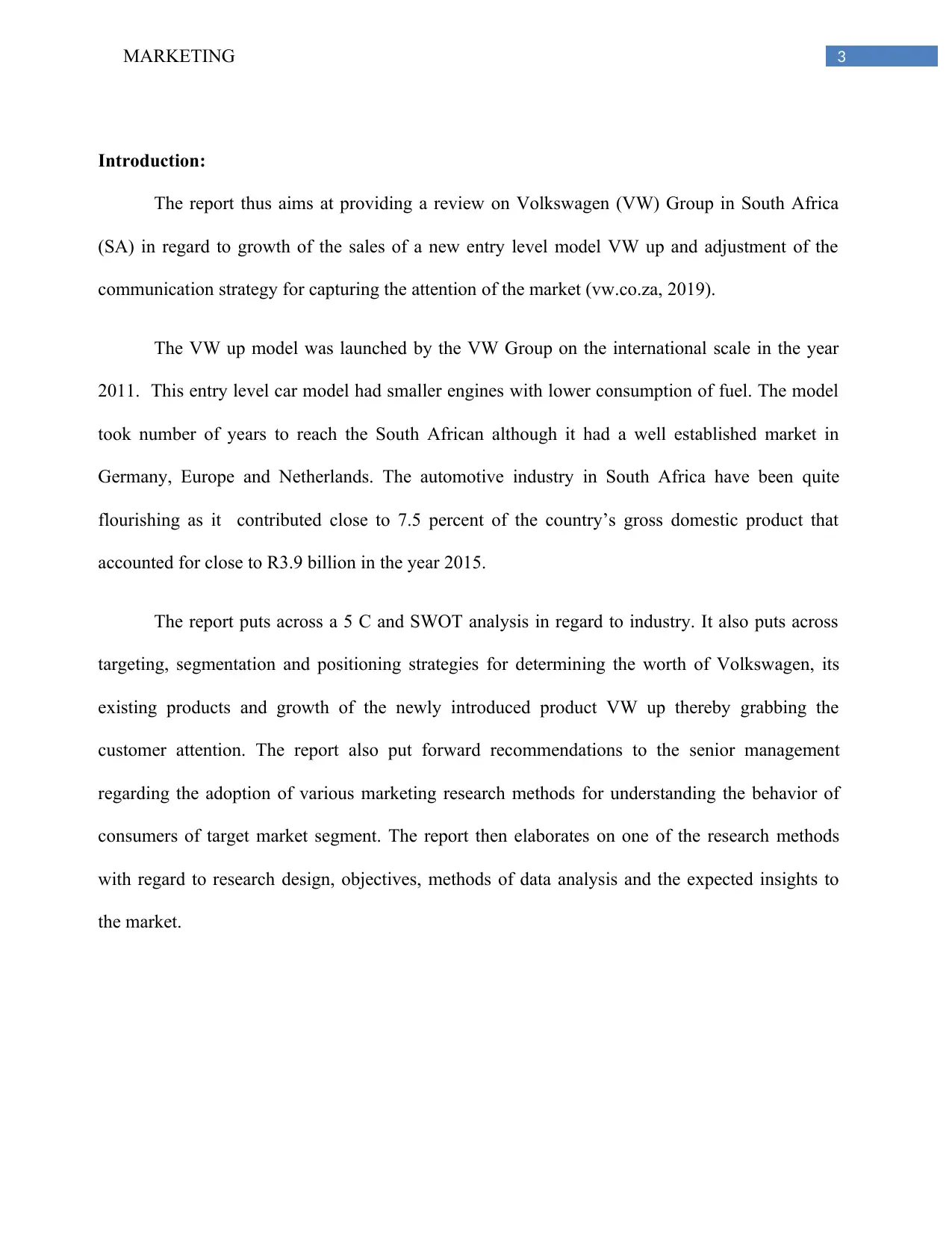
3MARKETING
Introduction:
The report thus aims at providing a review on Volkswagen (VW) Group in South Africa
(SA) in regard to growth of the sales of a new entry level model VW up and adjustment of the
communication strategy for capturing the attention of the market (vw.co.za, 2019).
The VW up model was launched by the VW Group on the international scale in the year
2011. This entry level car model had smaller engines with lower consumption of fuel. The model
took number of years to reach the South African although it had a well established market in
Germany, Europe and Netherlands. The automotive industry in South Africa have been quite
flourishing as it contributed close to 7.5 percent of the country’s gross domestic product that
accounted for close to R3.9 billion in the year 2015.
The report puts across a 5 C and SWOT analysis in regard to industry. It also puts across
targeting, segmentation and positioning strategies for determining the worth of Volkswagen, its
existing products and growth of the newly introduced product VW up thereby grabbing the
customer attention. The report also put forward recommendations to the senior management
regarding the adoption of various marketing research methods for understanding the behavior of
consumers of target market segment. The report then elaborates on one of the research methods
with regard to research design, objectives, methods of data analysis and the expected insights to
the market.
Introduction:
The report thus aims at providing a review on Volkswagen (VW) Group in South Africa
(SA) in regard to growth of the sales of a new entry level model VW up and adjustment of the
communication strategy for capturing the attention of the market (vw.co.za, 2019).
The VW up model was launched by the VW Group on the international scale in the year
2011. This entry level car model had smaller engines with lower consumption of fuel. The model
took number of years to reach the South African although it had a well established market in
Germany, Europe and Netherlands. The automotive industry in South Africa have been quite
flourishing as it contributed close to 7.5 percent of the country’s gross domestic product that
accounted for close to R3.9 billion in the year 2015.
The report puts across a 5 C and SWOT analysis in regard to industry. It also puts across
targeting, segmentation and positioning strategies for determining the worth of Volkswagen, its
existing products and growth of the newly introduced product VW up thereby grabbing the
customer attention. The report also put forward recommendations to the senior management
regarding the adoption of various marketing research methods for understanding the behavior of
consumers of target market segment. The report then elaborates on one of the research methods
with regard to research design, objectives, methods of data analysis and the expected insights to
the market.
Secure Best Marks with AI Grader
Need help grading? Try our AI Grader for instant feedback on your assignments.
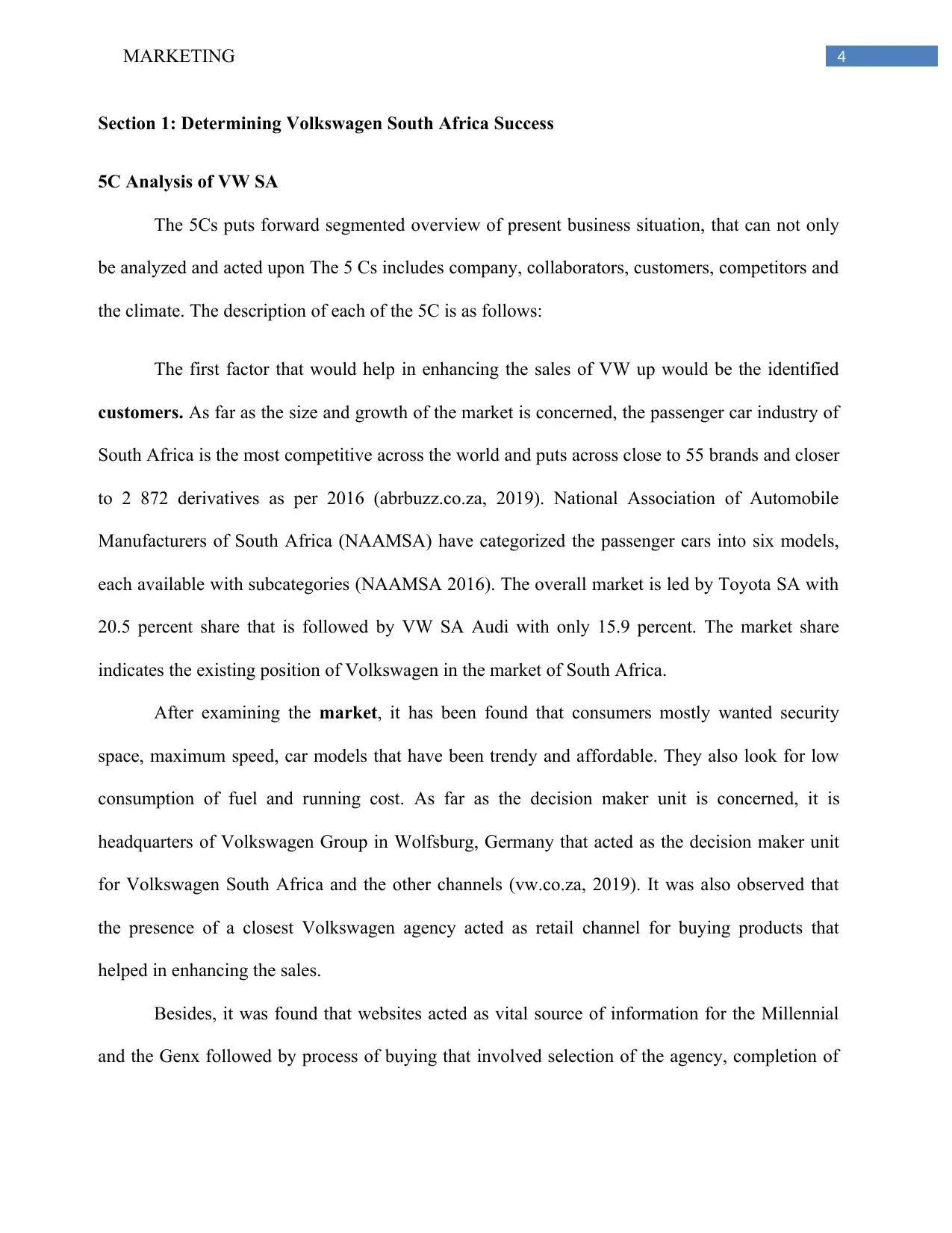
4MARKETING
Section 1: Determining Volkswagen South Africa Success
5C Analysis of VW SA
The 5Cs puts forward segmented overview of present business situation, that can not only
be analyzed and acted upon The 5 Cs includes company, collaborators, customers, competitors and
the climate. The description of each of the 5C is as follows:
The first factor that would help in enhancing the sales of VW up would be the identified
customers. As far as the size and growth of the market is concerned, the passenger car industry of
South Africa is the most competitive across the world and puts across close to 55 brands and closer
to 2 872 derivatives as per 2016 (abrbuzz.co.za, 2019). National Association of Automobile
Manufacturers of South Africa (NAAMSA) have categorized the passenger cars into six models,
each available with subcategories (NAAMSA 2016). The overall market is led by Toyota SA with
20.5 percent share that is followed by VW SA Audi with only 15.9 percent. The market share
indicates the existing position of Volkswagen in the market of South Africa.
After examining the market, it has been found that consumers mostly wanted security
space, maximum speed, car models that have been trendy and affordable. They also look for low
consumption of fuel and running cost. As far as the decision maker unit is concerned, it is
headquarters of Volkswagen Group in Wolfsburg, Germany that acted as the decision maker unit
for Volkswagen South Africa and the other channels (vw.co.za, 2019). It was also observed that
the presence of a closest Volkswagen agency acted as retail channel for buying products that
helped in enhancing the sales.
Besides, it was found that websites acted as vital source of information for the Millennial
and the Genx followed by process of buying that involved selection of the agency, completion of
Section 1: Determining Volkswagen South Africa Success
5C Analysis of VW SA
The 5Cs puts forward segmented overview of present business situation, that can not only
be analyzed and acted upon The 5 Cs includes company, collaborators, customers, competitors and
the climate. The description of each of the 5C is as follows:
The first factor that would help in enhancing the sales of VW up would be the identified
customers. As far as the size and growth of the market is concerned, the passenger car industry of
South Africa is the most competitive across the world and puts across close to 55 brands and closer
to 2 872 derivatives as per 2016 (abrbuzz.co.za, 2019). National Association of Automobile
Manufacturers of South Africa (NAAMSA) have categorized the passenger cars into six models,
each available with subcategories (NAAMSA 2016). The overall market is led by Toyota SA with
20.5 percent share that is followed by VW SA Audi with only 15.9 percent. The market share
indicates the existing position of Volkswagen in the market of South Africa.
After examining the market, it has been found that consumers mostly wanted security
space, maximum speed, car models that have been trendy and affordable. They also look for low
consumption of fuel and running cost. As far as the decision maker unit is concerned, it is
headquarters of Volkswagen Group in Wolfsburg, Germany that acted as the decision maker unit
for Volkswagen South Africa and the other channels (vw.co.za, 2019). It was also observed that
the presence of a closest Volkswagen agency acted as retail channel for buying products that
helped in enhancing the sales.
Besides, it was found that websites acted as vital source of information for the Millennial
and the Genx followed by process of buying that involved selection of the agency, completion of
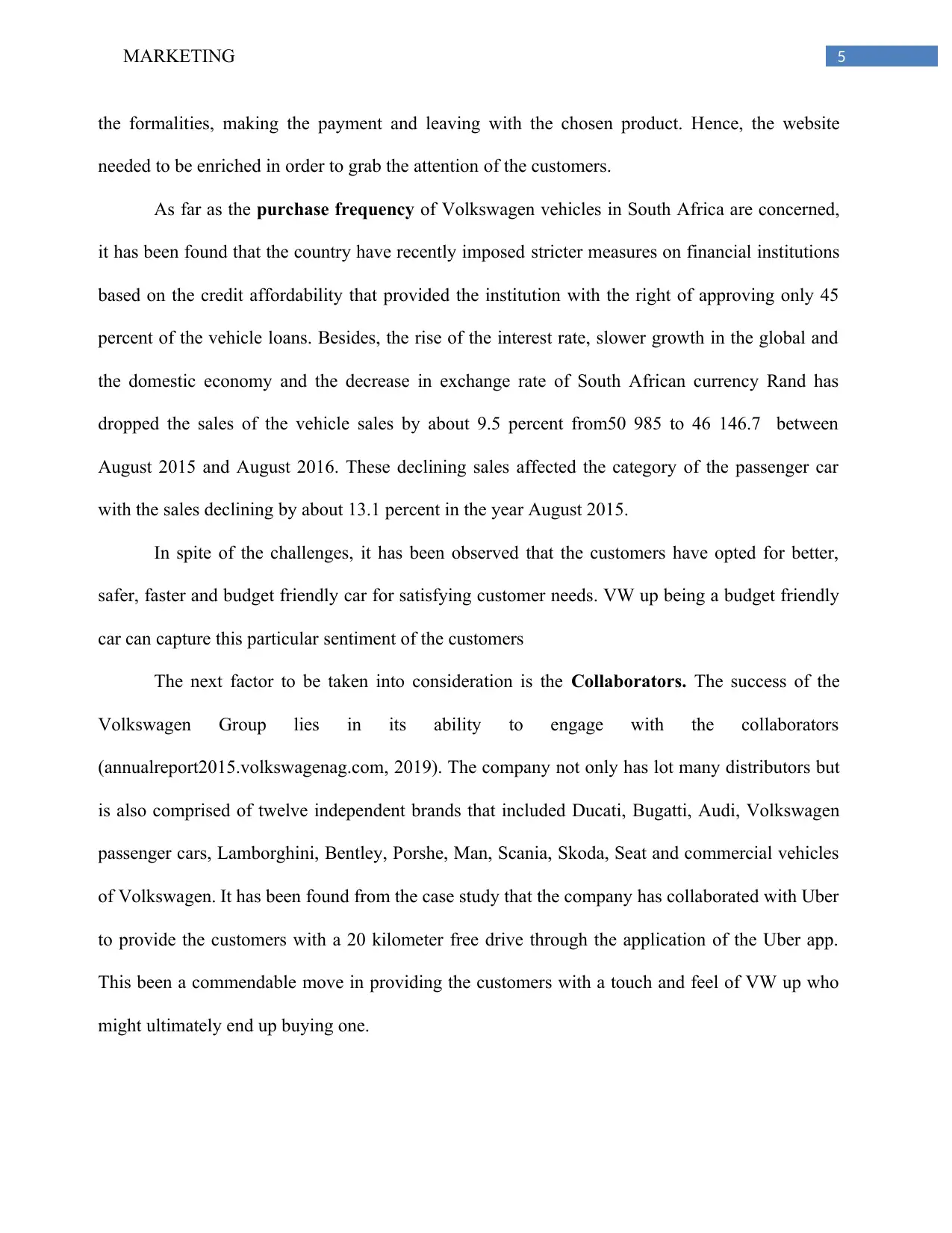
5MARKETING
the formalities, making the payment and leaving with the chosen product. Hence, the website
needed to be enriched in order to grab the attention of the customers.
As far as the purchase frequency of Volkswagen vehicles in South Africa are concerned,
it has been found that the country have recently imposed stricter measures on financial institutions
based on the credit affordability that provided the institution with the right of approving only 45
percent of the vehicle loans. Besides, the rise of the interest rate, slower growth in the global and
the domestic economy and the decrease in exchange rate of South African currency Rand has
dropped the sales of the vehicle sales by about 9.5 percent from50 985 to 46 146.7 between
August 2015 and August 2016. These declining sales affected the category of the passenger car
with the sales declining by about 13.1 percent in the year August 2015.
In spite of the challenges, it has been observed that the customers have opted for better,
safer, faster and budget friendly car for satisfying customer needs. VW up being a budget friendly
car can capture this particular sentiment of the customers
The next factor to be taken into consideration is the Collaborators. The success of the
Volkswagen Group lies in its ability to engage with the collaborators
(annualreport2015.volkswagenag.com, 2019). The company not only has lot many distributors but
is also comprised of twelve independent brands that included Ducati, Bugatti, Audi, Volkswagen
passenger cars, Lamborghini, Bentley, Porshe, Man, Scania, Skoda, Seat and commercial vehicles
of Volkswagen. It has been found from the case study that the company has collaborated with Uber
to provide the customers with a 20 kilometer free drive through the application of the Uber app.
This been a commendable move in providing the customers with a touch and feel of VW up who
might ultimately end up buying one.
the formalities, making the payment and leaving with the chosen product. Hence, the website
needed to be enriched in order to grab the attention of the customers.
As far as the purchase frequency of Volkswagen vehicles in South Africa are concerned,
it has been found that the country have recently imposed stricter measures on financial institutions
based on the credit affordability that provided the institution with the right of approving only 45
percent of the vehicle loans. Besides, the rise of the interest rate, slower growth in the global and
the domestic economy and the decrease in exchange rate of South African currency Rand has
dropped the sales of the vehicle sales by about 9.5 percent from50 985 to 46 146.7 between
August 2015 and August 2016. These declining sales affected the category of the passenger car
with the sales declining by about 13.1 percent in the year August 2015.
In spite of the challenges, it has been observed that the customers have opted for better,
safer, faster and budget friendly car for satisfying customer needs. VW up being a budget friendly
car can capture this particular sentiment of the customers
The next factor to be taken into consideration is the Collaborators. The success of the
Volkswagen Group lies in its ability to engage with the collaborators
(annualreport2015.volkswagenag.com, 2019). The company not only has lot many distributors but
is also comprised of twelve independent brands that included Ducati, Bugatti, Audi, Volkswagen
passenger cars, Lamborghini, Bentley, Porshe, Man, Scania, Skoda, Seat and commercial vehicles
of Volkswagen. It has been found from the case study that the company has collaborated with Uber
to provide the customers with a 20 kilometer free drive through the application of the Uber app.
This been a commendable move in providing the customers with a touch and feel of VW up who
might ultimately end up buying one.
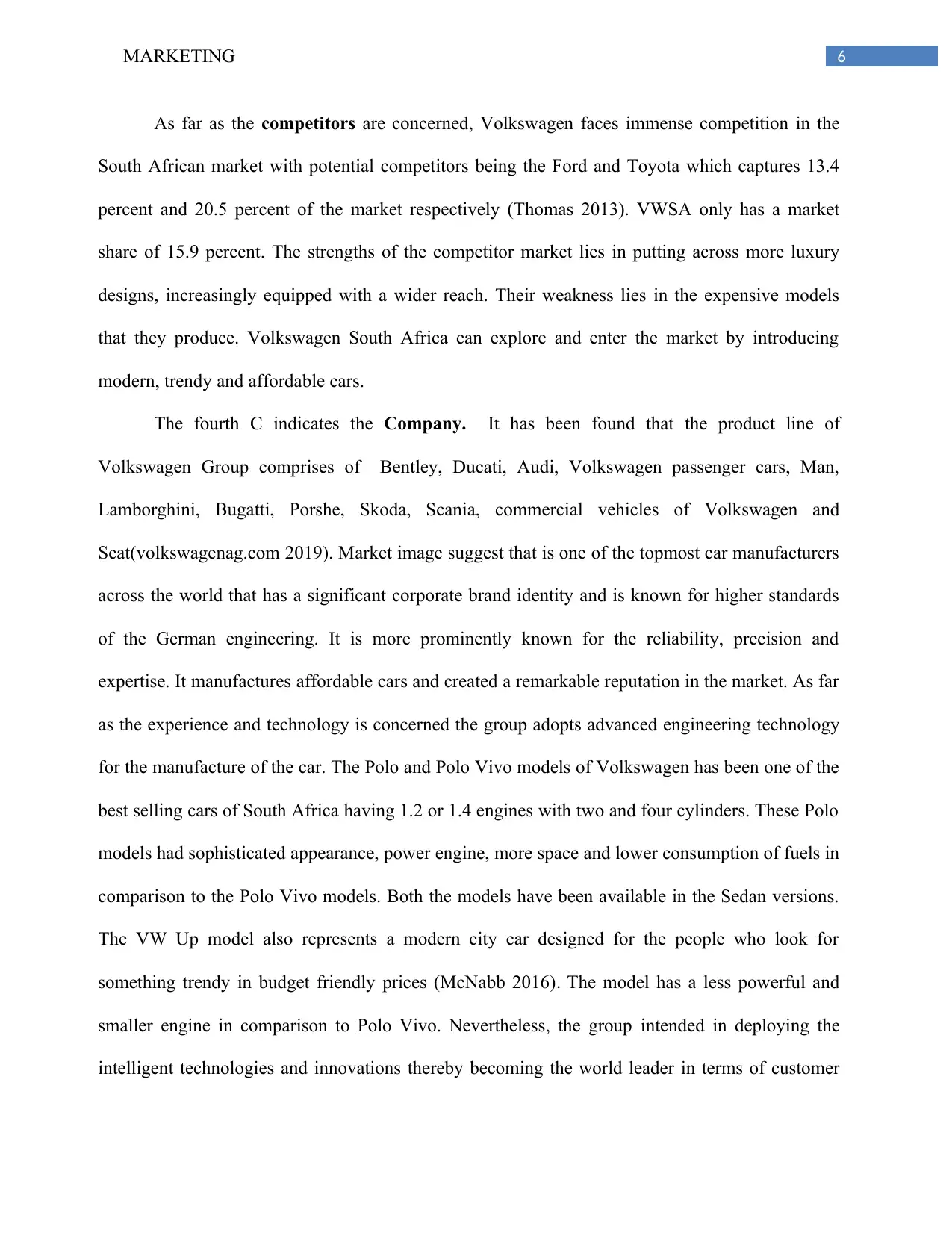
6MARKETING
As far as the competitors are concerned, Volkswagen faces immense competition in the
South African market with potential competitors being the Ford and Toyota which captures 13.4
percent and 20.5 percent of the market respectively (Thomas 2013). VWSA only has a market
share of 15.9 percent. The strengths of the competitor market lies in putting across more luxury
designs, increasingly equipped with a wider reach. Their weakness lies in the expensive models
that they produce. Volkswagen South Africa can explore and enter the market by introducing
modern, trendy and affordable cars.
The fourth C indicates the Company. It has been found that the product line of
Volkswagen Group comprises of Bentley, Ducati, Audi, Volkswagen passenger cars, Man,
Lamborghini, Bugatti, Porshe, Skoda, Scania, commercial vehicles of Volkswagen and
Seat(volkswagenag.com 2019). Market image suggest that is one of the topmost car manufacturers
across the world that has a significant corporate brand identity and is known for higher standards
of the German engineering. It is more prominently known for the reliability, precision and
expertise. It manufactures affordable cars and created a remarkable reputation in the market. As far
as the experience and technology is concerned the group adopts advanced engineering technology
for the manufacture of the car. The Polo and Polo Vivo models of Volkswagen has been one of the
best selling cars of South Africa having 1.2 or 1.4 engines with two and four cylinders. These Polo
models had sophisticated appearance, power engine, more space and lower consumption of fuels in
comparison to the Polo Vivo models. Both the models have been available in the Sedan versions.
The VW Up model also represents a modern city car designed for the people who look for
something trendy in budget friendly prices (McNabb 2016). The model has a less powerful and
smaller engine in comparison to Polo Vivo. Nevertheless, the group intended in deploying the
intelligent technologies and innovations thereby becoming the world leader in terms of customer
As far as the competitors are concerned, Volkswagen faces immense competition in the
South African market with potential competitors being the Ford and Toyota which captures 13.4
percent and 20.5 percent of the market respectively (Thomas 2013). VWSA only has a market
share of 15.9 percent. The strengths of the competitor market lies in putting across more luxury
designs, increasingly equipped with a wider reach. Their weakness lies in the expensive models
that they produce. Volkswagen South Africa can explore and enter the market by introducing
modern, trendy and affordable cars.
The fourth C indicates the Company. It has been found that the product line of
Volkswagen Group comprises of Bentley, Ducati, Audi, Volkswagen passenger cars, Man,
Lamborghini, Bugatti, Porshe, Skoda, Scania, commercial vehicles of Volkswagen and
Seat(volkswagenag.com 2019). Market image suggest that is one of the topmost car manufacturers
across the world that has a significant corporate brand identity and is known for higher standards
of the German engineering. It is more prominently known for the reliability, precision and
expertise. It manufactures affordable cars and created a remarkable reputation in the market. As far
as the experience and technology is concerned the group adopts advanced engineering technology
for the manufacture of the car. The Polo and Polo Vivo models of Volkswagen has been one of the
best selling cars of South Africa having 1.2 or 1.4 engines with two and four cylinders. These Polo
models had sophisticated appearance, power engine, more space and lower consumption of fuels in
comparison to the Polo Vivo models. Both the models have been available in the Sedan versions.
The VW Up model also represents a modern city car designed for the people who look for
something trendy in budget friendly prices (McNabb 2016). The model has a less powerful and
smaller engine in comparison to Polo Vivo. Nevertheless, the group intended in deploying the
intelligent technologies and innovations thereby becoming the world leader in terms of customer
Paraphrase This Document
Need a fresh take? Get an instant paraphrase of this document with our AI Paraphraser
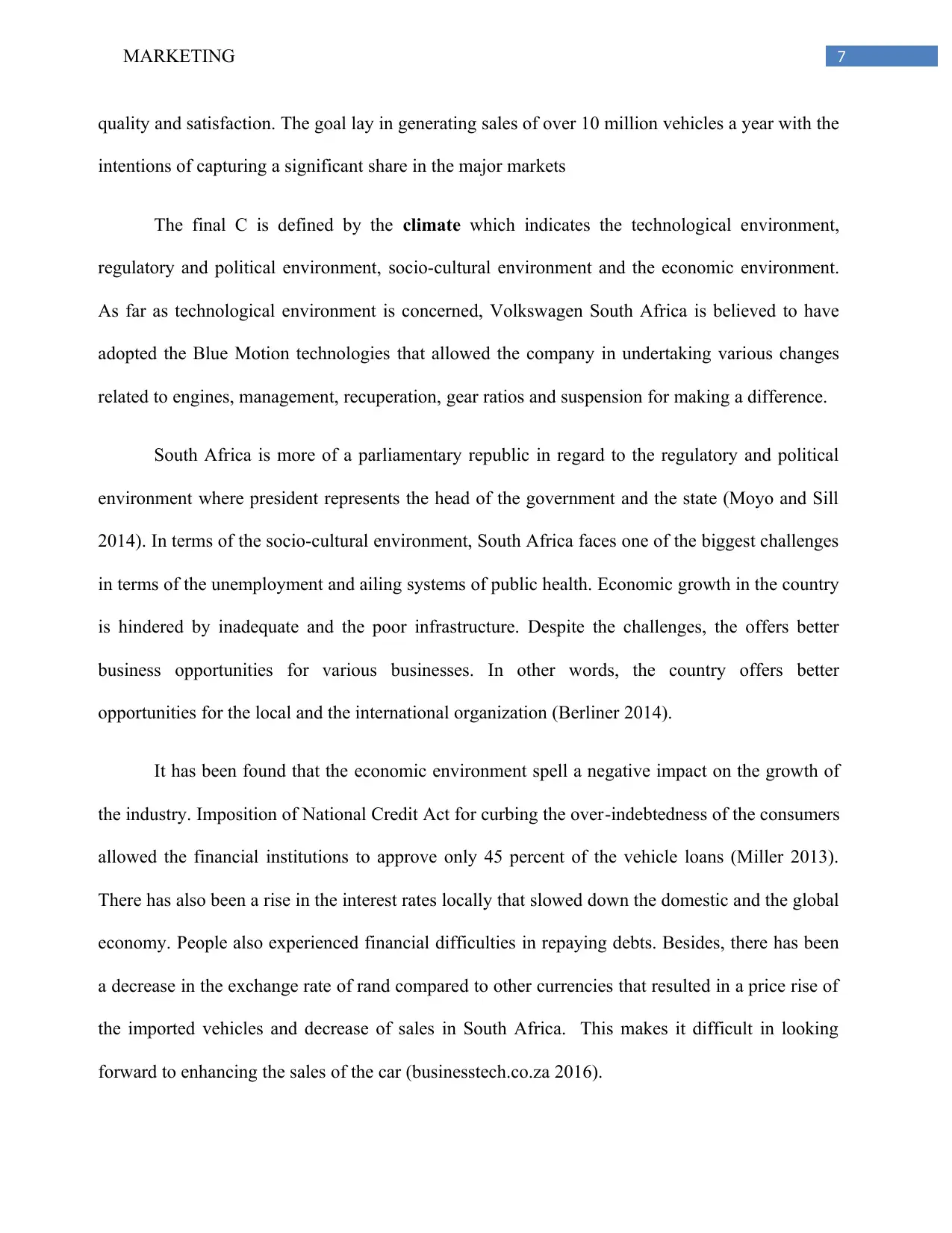
7MARKETING
quality and satisfaction. The goal lay in generating sales of over 10 million vehicles a year with the
intentions of capturing a significant share in the major markets
The final C is defined by the climate which indicates the technological environment,
regulatory and political environment, socio-cultural environment and the economic environment.
As far as technological environment is concerned, Volkswagen South Africa is believed to have
adopted the Blue Motion technologies that allowed the company in undertaking various changes
related to engines, management, recuperation, gear ratios and suspension for making a difference.
South Africa is more of a parliamentary republic in regard to the regulatory and political
environment where president represents the head of the government and the state (Moyo and Sill
2014). In terms of the socio-cultural environment, South Africa faces one of the biggest challenges
in terms of the unemployment and ailing systems of public health. Economic growth in the country
is hindered by inadequate and the poor infrastructure. Despite the challenges, the offers better
business opportunities for various businesses. In other words, the country offers better
opportunities for the local and the international organization (Berliner 2014).
It has been found that the economic environment spell a negative impact on the growth of
the industry. Imposition of National Credit Act for curbing the over-indebtedness of the consumers
allowed the financial institutions to approve only 45 percent of the vehicle loans (Miller 2013).
There has also been a rise in the interest rates locally that slowed down the domestic and the global
economy. People also experienced financial difficulties in repaying debts. Besides, there has been
a decrease in the exchange rate of rand compared to other currencies that resulted in a price rise of
the imported vehicles and decrease of sales in South Africa. This makes it difficult in looking
forward to enhancing the sales of the car (businesstech.co.za 2016).
quality and satisfaction. The goal lay in generating sales of over 10 million vehicles a year with the
intentions of capturing a significant share in the major markets
The final C is defined by the climate which indicates the technological environment,
regulatory and political environment, socio-cultural environment and the economic environment.
As far as technological environment is concerned, Volkswagen South Africa is believed to have
adopted the Blue Motion technologies that allowed the company in undertaking various changes
related to engines, management, recuperation, gear ratios and suspension for making a difference.
South Africa is more of a parliamentary republic in regard to the regulatory and political
environment where president represents the head of the government and the state (Moyo and Sill
2014). In terms of the socio-cultural environment, South Africa faces one of the biggest challenges
in terms of the unemployment and ailing systems of public health. Economic growth in the country
is hindered by inadequate and the poor infrastructure. Despite the challenges, the offers better
business opportunities for various businesses. In other words, the country offers better
opportunities for the local and the international organization (Berliner 2014).
It has been found that the economic environment spell a negative impact on the growth of
the industry. Imposition of National Credit Act for curbing the over-indebtedness of the consumers
allowed the financial institutions to approve only 45 percent of the vehicle loans (Miller 2013).
There has also been a rise in the interest rates locally that slowed down the domestic and the global
economy. People also experienced financial difficulties in repaying debts. Besides, there has been
a decrease in the exchange rate of rand compared to other currencies that resulted in a price rise of
the imported vehicles and decrease of sales in South Africa. This makes it difficult in looking
forward to enhancing the sales of the car (businesstech.co.za 2016).
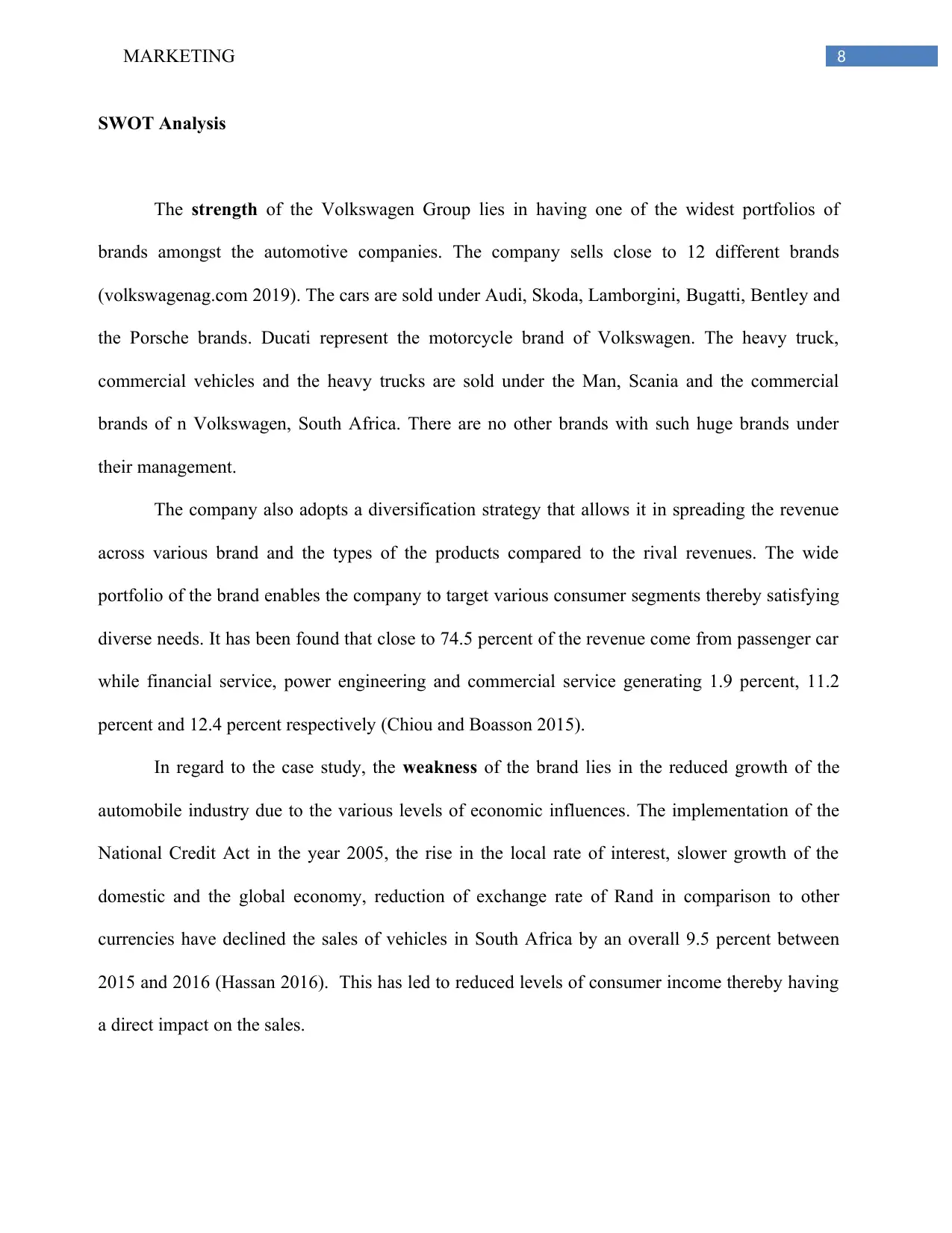
8MARKETING
SWOT Analysis
The strength of the Volkswagen Group lies in having one of the widest portfolios of
brands amongst the automotive companies. The company sells close to 12 different brands
(volkswagenag.com 2019). The cars are sold under Audi, Skoda, Lamborgini, Bugatti, Bentley and
the Porsche brands. Ducati represent the motorcycle brand of Volkswagen. The heavy truck,
commercial vehicles and the heavy trucks are sold under the Man, Scania and the commercial
brands of n Volkswagen, South Africa. There are no other brands with such huge brands under
their management.
The company also adopts a diversification strategy that allows it in spreading the revenue
across various brand and the types of the products compared to the rival revenues. The wide
portfolio of the brand enables the company to target various consumer segments thereby satisfying
diverse needs. It has been found that close to 74.5 percent of the revenue come from passenger car
while financial service, power engineering and commercial service generating 1.9 percent, 11.2
percent and 12.4 percent respectively (Chiou and Boasson 2015).
In regard to the case study, the weakness of the brand lies in the reduced growth of the
automobile industry due to the various levels of economic influences. The implementation of the
National Credit Act in the year 2005, the rise in the local rate of interest, slower growth of the
domestic and the global economy, reduction of exchange rate of Rand in comparison to other
currencies have declined the sales of vehicles in South Africa by an overall 9.5 percent between
2015 and 2016 (Hassan 2016). This has led to reduced levels of consumer income thereby having
a direct impact on the sales.
SWOT Analysis
The strength of the Volkswagen Group lies in having one of the widest portfolios of
brands amongst the automotive companies. The company sells close to 12 different brands
(volkswagenag.com 2019). The cars are sold under Audi, Skoda, Lamborgini, Bugatti, Bentley and
the Porsche brands. Ducati represent the motorcycle brand of Volkswagen. The heavy truck,
commercial vehicles and the heavy trucks are sold under the Man, Scania and the commercial
brands of n Volkswagen, South Africa. There are no other brands with such huge brands under
their management.
The company also adopts a diversification strategy that allows it in spreading the revenue
across various brand and the types of the products compared to the rival revenues. The wide
portfolio of the brand enables the company to target various consumer segments thereby satisfying
diverse needs. It has been found that close to 74.5 percent of the revenue come from passenger car
while financial service, power engineering and commercial service generating 1.9 percent, 11.2
percent and 12.4 percent respectively (Chiou and Boasson 2015).
In regard to the case study, the weakness of the brand lies in the reduced growth of the
automobile industry due to the various levels of economic influences. The implementation of the
National Credit Act in the year 2005, the rise in the local rate of interest, slower growth of the
domestic and the global economy, reduction of exchange rate of Rand in comparison to other
currencies have declined the sales of vehicles in South Africa by an overall 9.5 percent between
2015 and 2016 (Hassan 2016). This has led to reduced levels of consumer income thereby having
a direct impact on the sales.
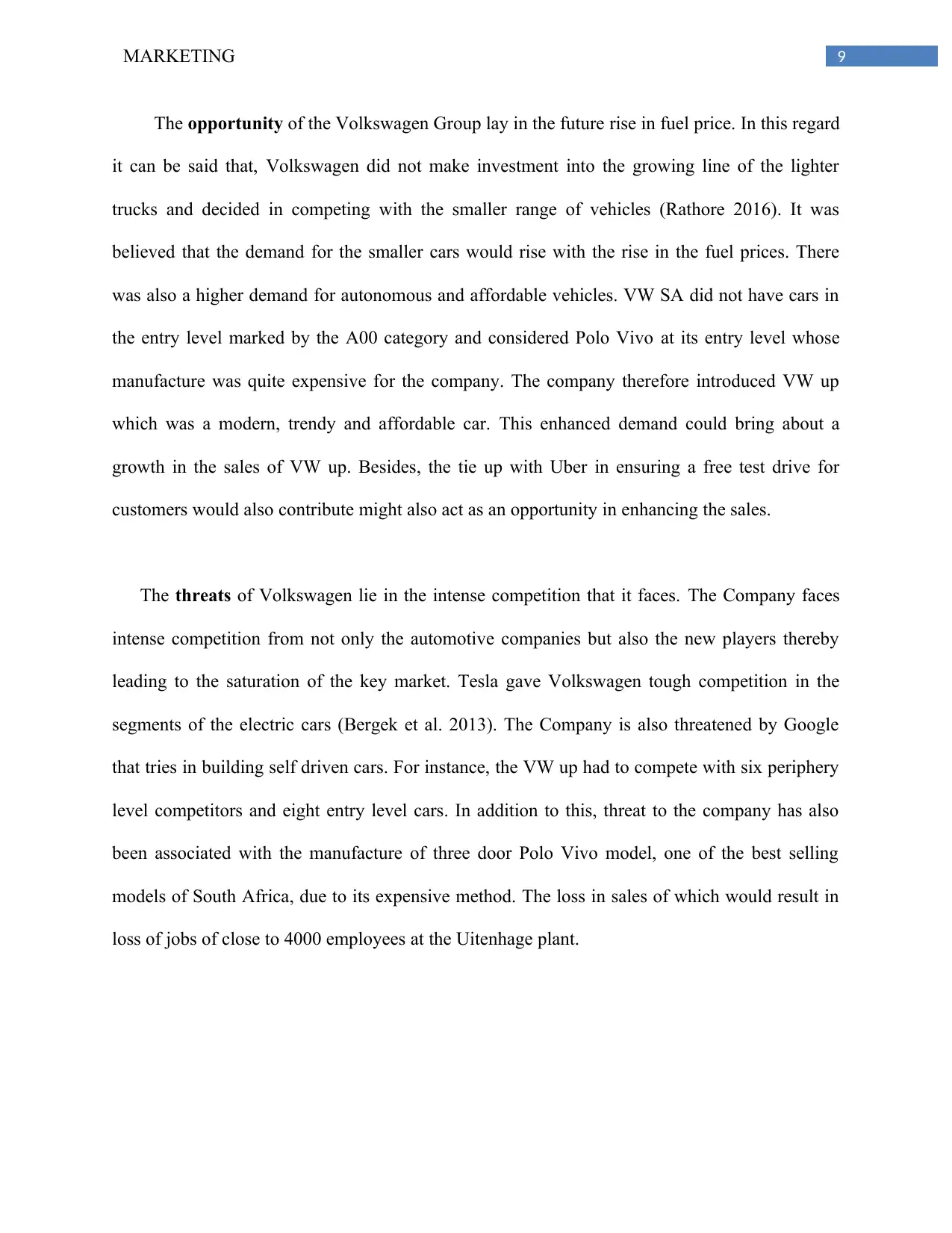
9MARKETING
The opportunity of the Volkswagen Group lay in the future rise in fuel price. In this regard
it can be said that, Volkswagen did not make investment into the growing line of the lighter
trucks and decided in competing with the smaller range of vehicles (Rathore 2016). It was
believed that the demand for the smaller cars would rise with the rise in the fuel prices. There
was also a higher demand for autonomous and affordable vehicles. VW SA did not have cars in
the entry level marked by the A00 category and considered Polo Vivo at its entry level whose
manufacture was quite expensive for the company. The company therefore introduced VW up
which was a modern, trendy and affordable car. This enhanced demand could bring about a
growth in the sales of VW up. Besides, the tie up with Uber in ensuring a free test drive for
customers would also contribute might also act as an opportunity in enhancing the sales.
The threats of Volkswagen lie in the intense competition that it faces. The Company faces
intense competition from not only the automotive companies but also the new players thereby
leading to the saturation of the key market. Tesla gave Volkswagen tough competition in the
segments of the electric cars (Bergek et al. 2013). The Company is also threatened by Google
that tries in building self driven cars. For instance, the VW up had to compete with six periphery
level competitors and eight entry level cars. In addition to this, threat to the company has also
been associated with the manufacture of three door Polo Vivo model, one of the best selling
models of South Africa, due to its expensive method. The loss in sales of which would result in
loss of jobs of close to 4000 employees at the Uitenhage plant.
The opportunity of the Volkswagen Group lay in the future rise in fuel price. In this regard
it can be said that, Volkswagen did not make investment into the growing line of the lighter
trucks and decided in competing with the smaller range of vehicles (Rathore 2016). It was
believed that the demand for the smaller cars would rise with the rise in the fuel prices. There
was also a higher demand for autonomous and affordable vehicles. VW SA did not have cars in
the entry level marked by the A00 category and considered Polo Vivo at its entry level whose
manufacture was quite expensive for the company. The company therefore introduced VW up
which was a modern, trendy and affordable car. This enhanced demand could bring about a
growth in the sales of VW up. Besides, the tie up with Uber in ensuring a free test drive for
customers would also contribute might also act as an opportunity in enhancing the sales.
The threats of Volkswagen lie in the intense competition that it faces. The Company faces
intense competition from not only the automotive companies but also the new players thereby
leading to the saturation of the key market. Tesla gave Volkswagen tough competition in the
segments of the electric cars (Bergek et al. 2013). The Company is also threatened by Google
that tries in building self driven cars. For instance, the VW up had to compete with six periphery
level competitors and eight entry level cars. In addition to this, threat to the company has also
been associated with the manufacture of three door Polo Vivo model, one of the best selling
models of South Africa, due to its expensive method. The loss in sales of which would result in
loss of jobs of close to 4000 employees at the Uitenhage plant.
Secure Best Marks with AI Grader
Need help grading? Try our AI Grader for instant feedback on your assignments.
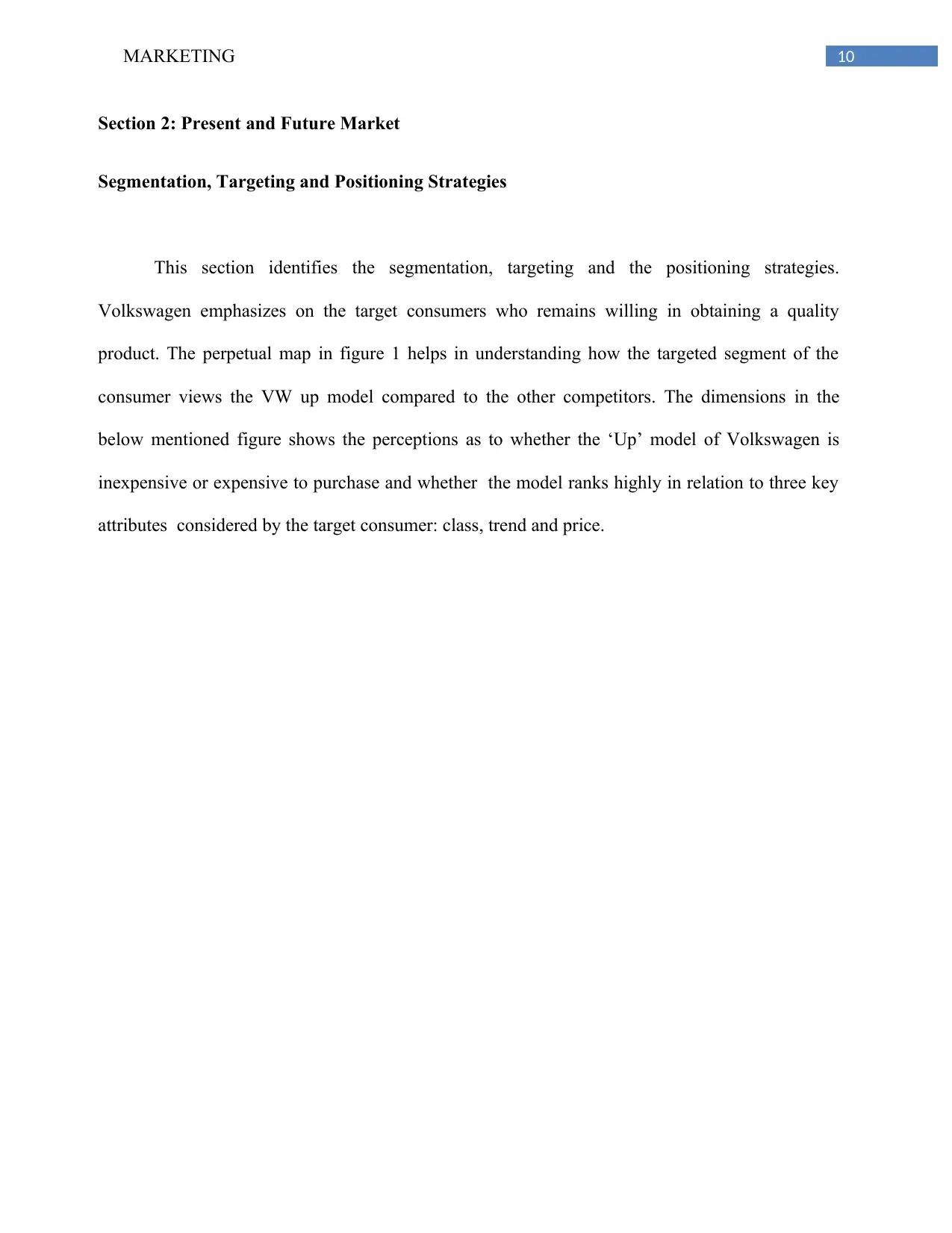
10MARKETING
Section 2: Present and Future Market
Segmentation, Targeting and Positioning Strategies
This section identifies the segmentation, targeting and the positioning strategies.
Volkswagen emphasizes on the target consumers who remains willing in obtaining a quality
product. The perpetual map in figure 1 helps in understanding how the targeted segment of the
consumer views the VW up model compared to the other competitors. The dimensions in the
below mentioned figure shows the perceptions as to whether the ‘Up’ model of Volkswagen is
inexpensive or expensive to purchase and whether the model ranks highly in relation to three key
attributes considered by the target consumer: class, trend and price.
Section 2: Present and Future Market
Segmentation, Targeting and Positioning Strategies
This section identifies the segmentation, targeting and the positioning strategies.
Volkswagen emphasizes on the target consumers who remains willing in obtaining a quality
product. The perpetual map in figure 1 helps in understanding how the targeted segment of the
consumer views the VW up model compared to the other competitors. The dimensions in the
below mentioned figure shows the perceptions as to whether the ‘Up’ model of Volkswagen is
inexpensive or expensive to purchase and whether the model ranks highly in relation to three key
attributes considered by the target consumer: class, trend and price.
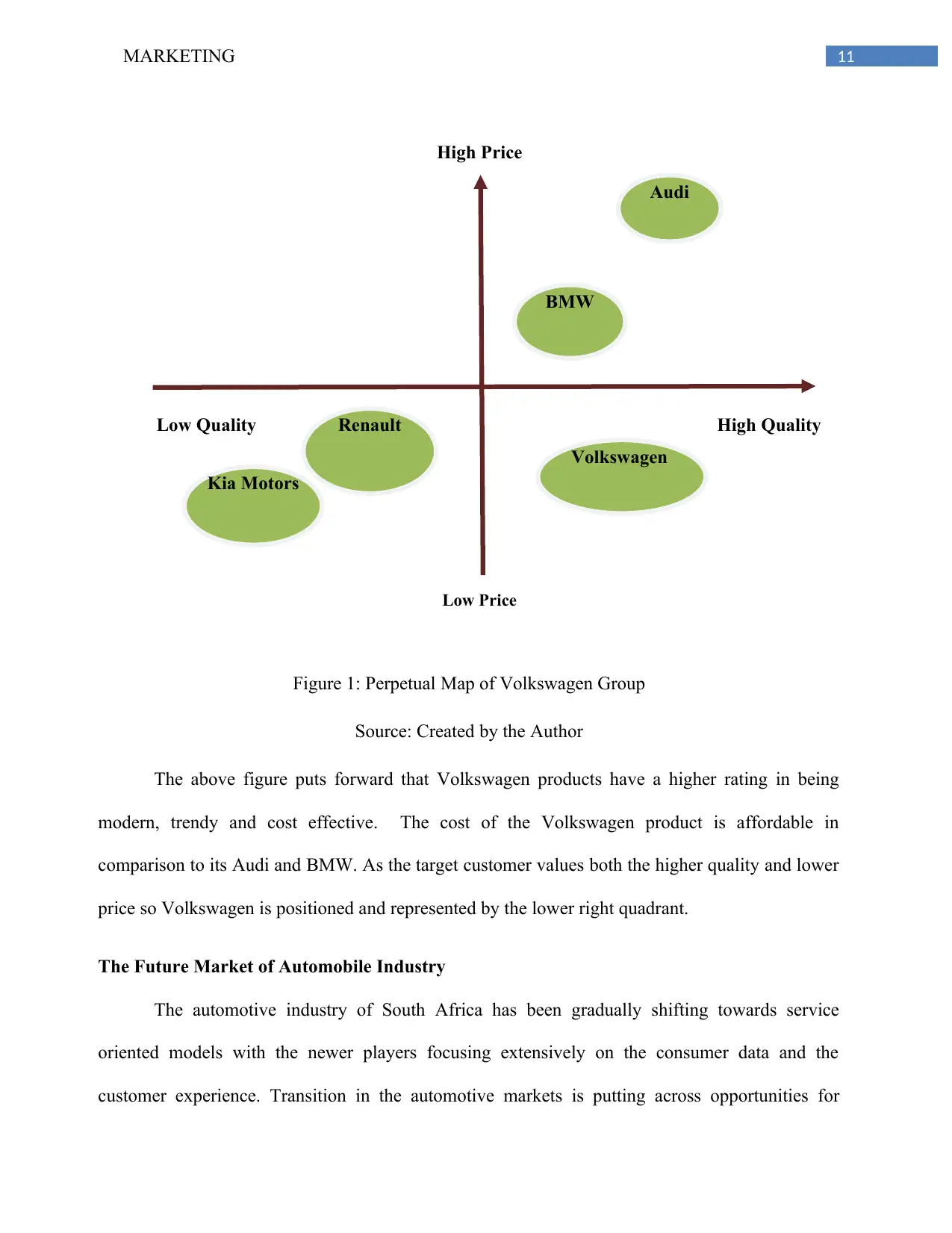
11MARKETING
Low Price
High Quality
High Price
Low Quality
BMW
Audi
Volkswagen
Kia Motors
Renault
Figure 1: Perpetual Map of Volkswagen Group
Source: Created by the Author
The above figure puts forward that Volkswagen products have a higher rating in being
modern, trendy and cost effective. The cost of the Volkswagen product is affordable in
comparison to its Audi and BMW. As the target customer values both the higher quality and lower
price so Volkswagen is positioned and represented by the lower right quadrant.
The Future Market of Automobile Industry
The automotive industry of South Africa has been gradually shifting towards service
oriented models with the newer players focusing extensively on the consumer data and the
customer experience. Transition in the automotive markets is putting across opportunities for
Low Price
High Quality
High Price
Low Quality
BMW
Audi
Volkswagen
Kia Motors
Renault
Figure 1: Perpetual Map of Volkswagen Group
Source: Created by the Author
The above figure puts forward that Volkswagen products have a higher rating in being
modern, trendy and cost effective. The cost of the Volkswagen product is affordable in
comparison to its Audi and BMW. As the target customer values both the higher quality and lower
price so Volkswagen is positioned and represented by the lower right quadrant.
The Future Market of Automobile Industry
The automotive industry of South Africa has been gradually shifting towards service
oriented models with the newer players focusing extensively on the consumer data and the
customer experience. Transition in the automotive markets is putting across opportunities for
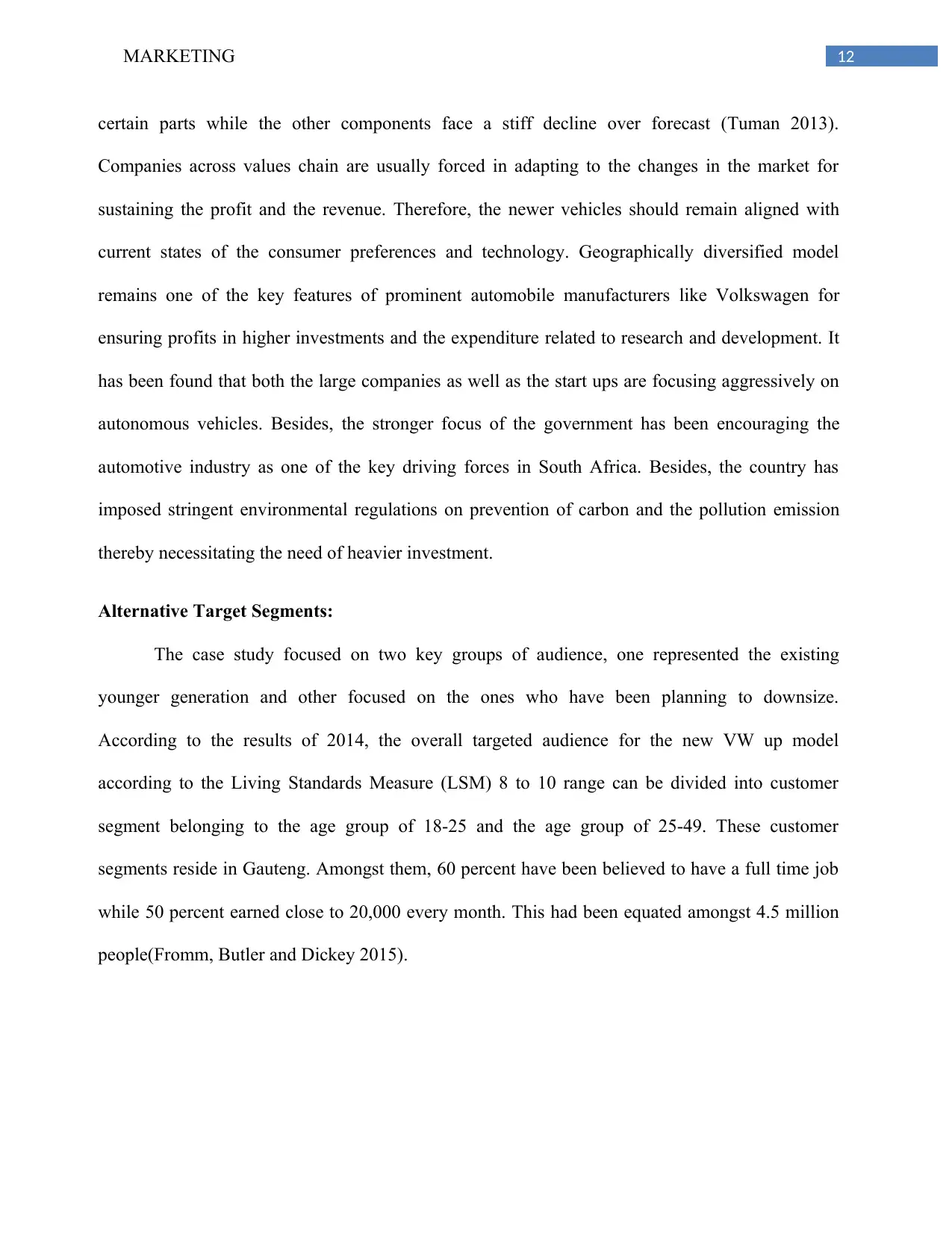
12MARKETING
certain parts while the other components face a stiff decline over forecast (Tuman 2013).
Companies across values chain are usually forced in adapting to the changes in the market for
sustaining the profit and the revenue. Therefore, the newer vehicles should remain aligned with
current states of the consumer preferences and technology. Geographically diversified model
remains one of the key features of prominent automobile manufacturers like Volkswagen for
ensuring profits in higher investments and the expenditure related to research and development. It
has been found that both the large companies as well as the start ups are focusing aggressively on
autonomous vehicles. Besides, the stronger focus of the government has been encouraging the
automotive industry as one of the key driving forces in South Africa. Besides, the country has
imposed stringent environmental regulations on prevention of carbon and the pollution emission
thereby necessitating the need of heavier investment.
Alternative Target Segments:
The case study focused on two key groups of audience, one represented the existing
younger generation and other focused on the ones who have been planning to downsize.
According to the results of 2014, the overall targeted audience for the new VW up model
according to the Living Standards Measure (LSM) 8 to 10 range can be divided into customer
segment belonging to the age group of 18-25 and the age group of 25-49. These customer
segments reside in Gauteng. Amongst them, 60 percent have been believed to have a full time job
while 50 percent earned close to 20,000 every month. This had been equated amongst 4.5 million
people(Fromm, Butler and Dickey 2015).
certain parts while the other components face a stiff decline over forecast (Tuman 2013).
Companies across values chain are usually forced in adapting to the changes in the market for
sustaining the profit and the revenue. Therefore, the newer vehicles should remain aligned with
current states of the consumer preferences and technology. Geographically diversified model
remains one of the key features of prominent automobile manufacturers like Volkswagen for
ensuring profits in higher investments and the expenditure related to research and development. It
has been found that both the large companies as well as the start ups are focusing aggressively on
autonomous vehicles. Besides, the stronger focus of the government has been encouraging the
automotive industry as one of the key driving forces in South Africa. Besides, the country has
imposed stringent environmental regulations on prevention of carbon and the pollution emission
thereby necessitating the need of heavier investment.
Alternative Target Segments:
The case study focused on two key groups of audience, one represented the existing
younger generation and other focused on the ones who have been planning to downsize.
According to the results of 2014, the overall targeted audience for the new VW up model
according to the Living Standards Measure (LSM) 8 to 10 range can be divided into customer
segment belonging to the age group of 18-25 and the age group of 25-49. These customer
segments reside in Gauteng. Amongst them, 60 percent have been believed to have a full time job
while 50 percent earned close to 20,000 every month. This had been equated amongst 4.5 million
people(Fromm, Butler and Dickey 2015).
Paraphrase This Document
Need a fresh take? Get an instant paraphrase of this document with our AI Paraphraser
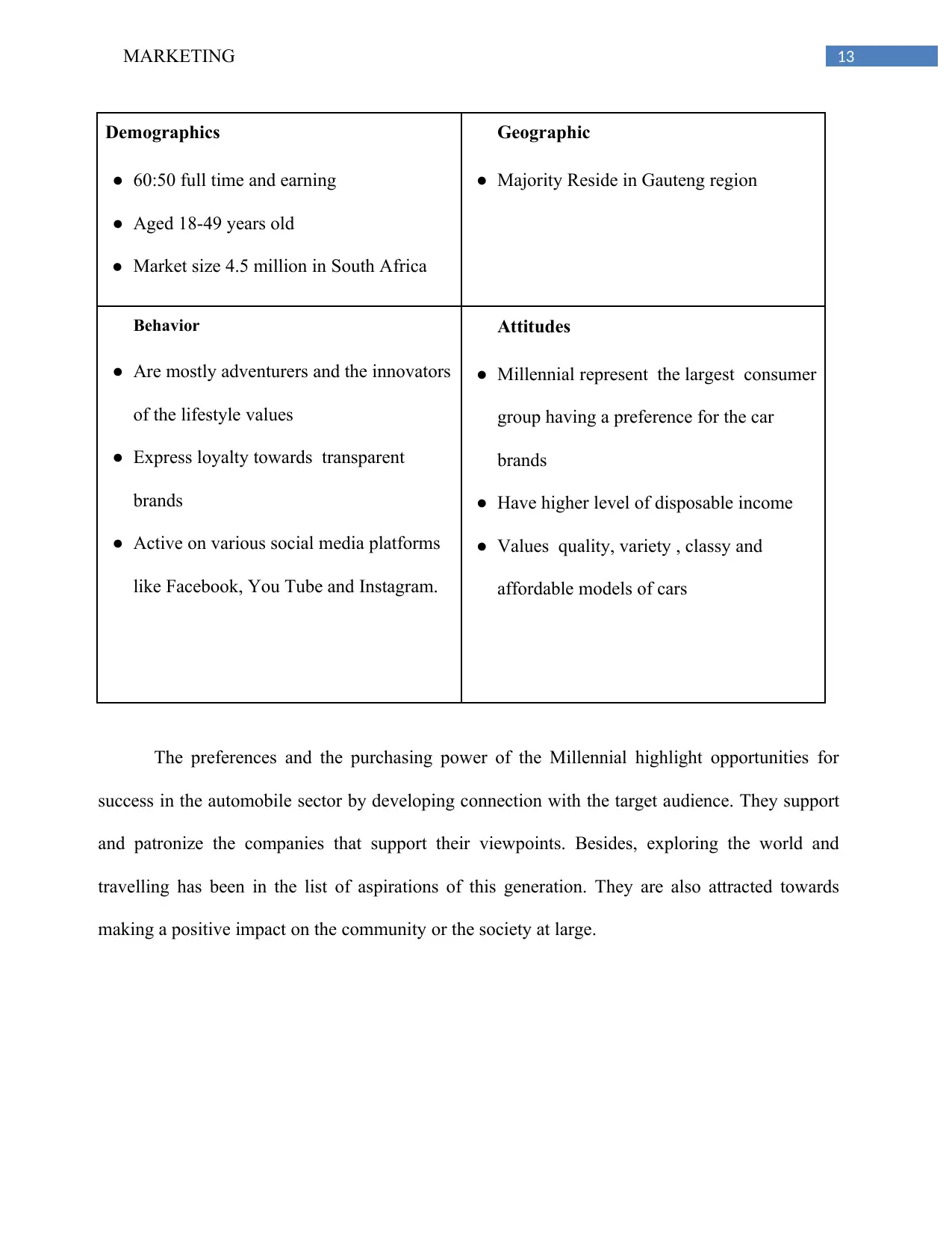
13MARKETING
Demographics
● 60:50 full time and earning
● Aged 18-49 years old
● Market size 4.5 million in South Africa
Geographic
● Majority Reside in Gauteng region
Behavior
● Are mostly adventurers and the innovators
of the lifestyle values
● Express loyalty towards transparent
brands
● Active on various social media platforms
like Facebook, You Tube and Instagram.
Attitudes
● Millennial represent the largest consumer
group having a preference for the car
brands
● Have higher level of disposable income
● Values quality, variety , classy and
affordable models of cars
The preferences and the purchasing power of the Millennial highlight opportunities for
success in the automobile sector by developing connection with the target audience. They support
and patronize the companies that support their viewpoints. Besides, exploring the world and
travelling has been in the list of aspirations of this generation. They are also attracted towards
making a positive impact on the community or the society at large.
Demographics
● 60:50 full time and earning
● Aged 18-49 years old
● Market size 4.5 million in South Africa
Geographic
● Majority Reside in Gauteng region
Behavior
● Are mostly adventurers and the innovators
of the lifestyle values
● Express loyalty towards transparent
brands
● Active on various social media platforms
like Facebook, You Tube and Instagram.
Attitudes
● Millennial represent the largest consumer
group having a preference for the car
brands
● Have higher level of disposable income
● Values quality, variety , classy and
affordable models of cars
The preferences and the purchasing power of the Millennial highlight opportunities for
success in the automobile sector by developing connection with the target audience. They support
and patronize the companies that support their viewpoints. Besides, exploring the world and
travelling has been in the list of aspirations of this generation. They are also attracted towards
making a positive impact on the community or the society at large.
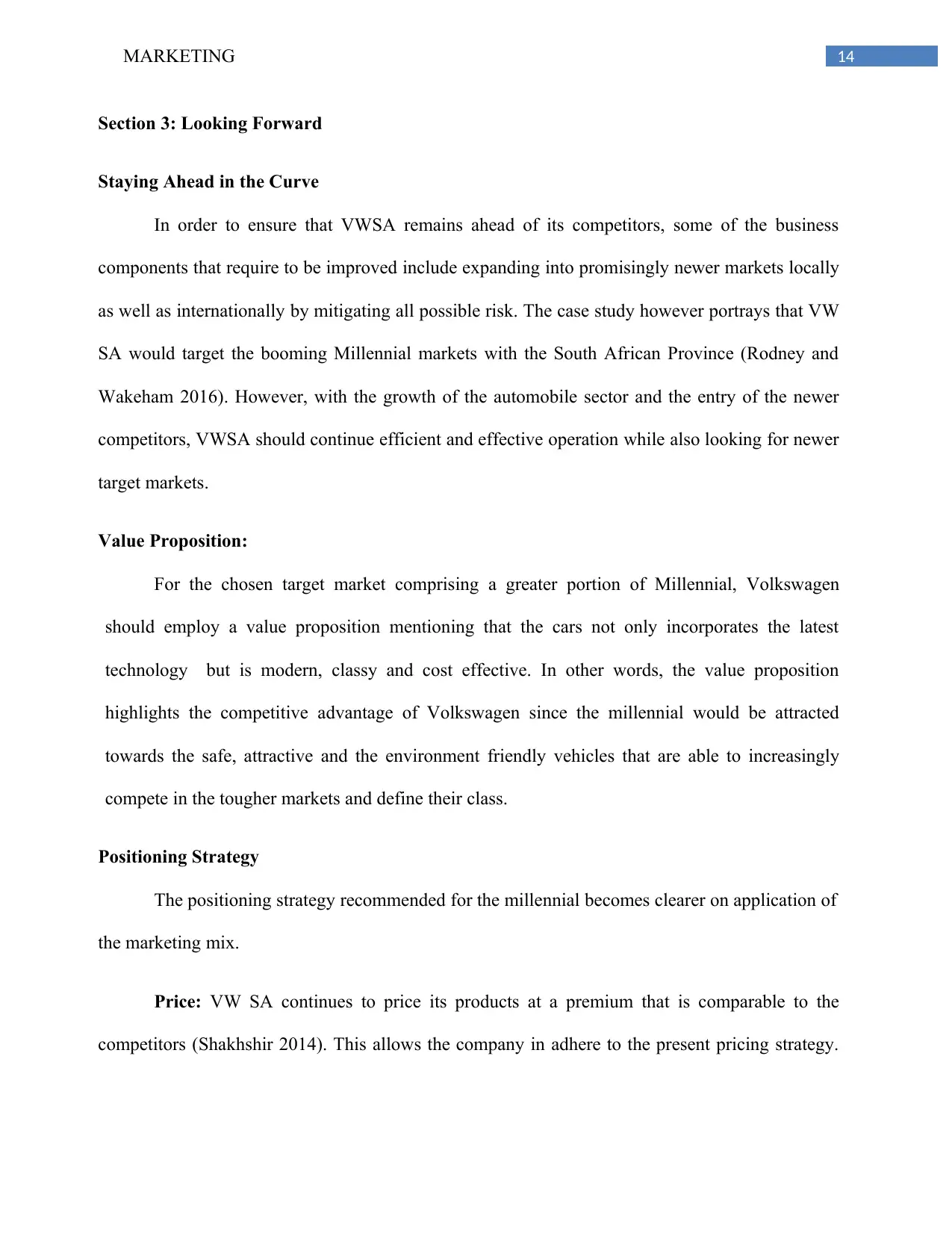
14MARKETING
Section 3: Looking Forward
Staying Ahead in the Curve
In order to ensure that VWSA remains ahead of its competitors, some of the business
components that require to be improved include expanding into promisingly newer markets locally
as well as internationally by mitigating all possible risk. The case study however portrays that VW
SA would target the booming Millennial markets with the South African Province (Rodney and
Wakeham 2016). However, with the growth of the automobile sector and the entry of the newer
competitors, VWSA should continue efficient and effective operation while also looking for newer
target markets.
Value Proposition:
For the chosen target market comprising a greater portion of Millennial, Volkswagen
should employ a value proposition mentioning that the cars not only incorporates the latest
technology but is modern, classy and cost effective. In other words, the value proposition
highlights the competitive advantage of Volkswagen since the millennial would be attracted
towards the safe, attractive and the environment friendly vehicles that are able to increasingly
compete in the tougher markets and define their class.
Positioning Strategy
The positioning strategy recommended for the millennial becomes clearer on application of
the marketing mix.
Price: VW SA continues to price its products at a premium that is comparable to the
competitors (Shakhshir 2014). This allows the company in adhere to the present pricing strategy.
Section 3: Looking Forward
Staying Ahead in the Curve
In order to ensure that VWSA remains ahead of its competitors, some of the business
components that require to be improved include expanding into promisingly newer markets locally
as well as internationally by mitigating all possible risk. The case study however portrays that VW
SA would target the booming Millennial markets with the South African Province (Rodney and
Wakeham 2016). However, with the growth of the automobile sector and the entry of the newer
competitors, VWSA should continue efficient and effective operation while also looking for newer
target markets.
Value Proposition:
For the chosen target market comprising a greater portion of Millennial, Volkswagen
should employ a value proposition mentioning that the cars not only incorporates the latest
technology but is modern, classy and cost effective. In other words, the value proposition
highlights the competitive advantage of Volkswagen since the millennial would be attracted
towards the safe, attractive and the environment friendly vehicles that are able to increasingly
compete in the tougher markets and define their class.
Positioning Strategy
The positioning strategy recommended for the millennial becomes clearer on application of
the marketing mix.
Price: VW SA continues to price its products at a premium that is comparable to the
competitors (Shakhshir 2014). This allows the company in adhere to the present pricing strategy.
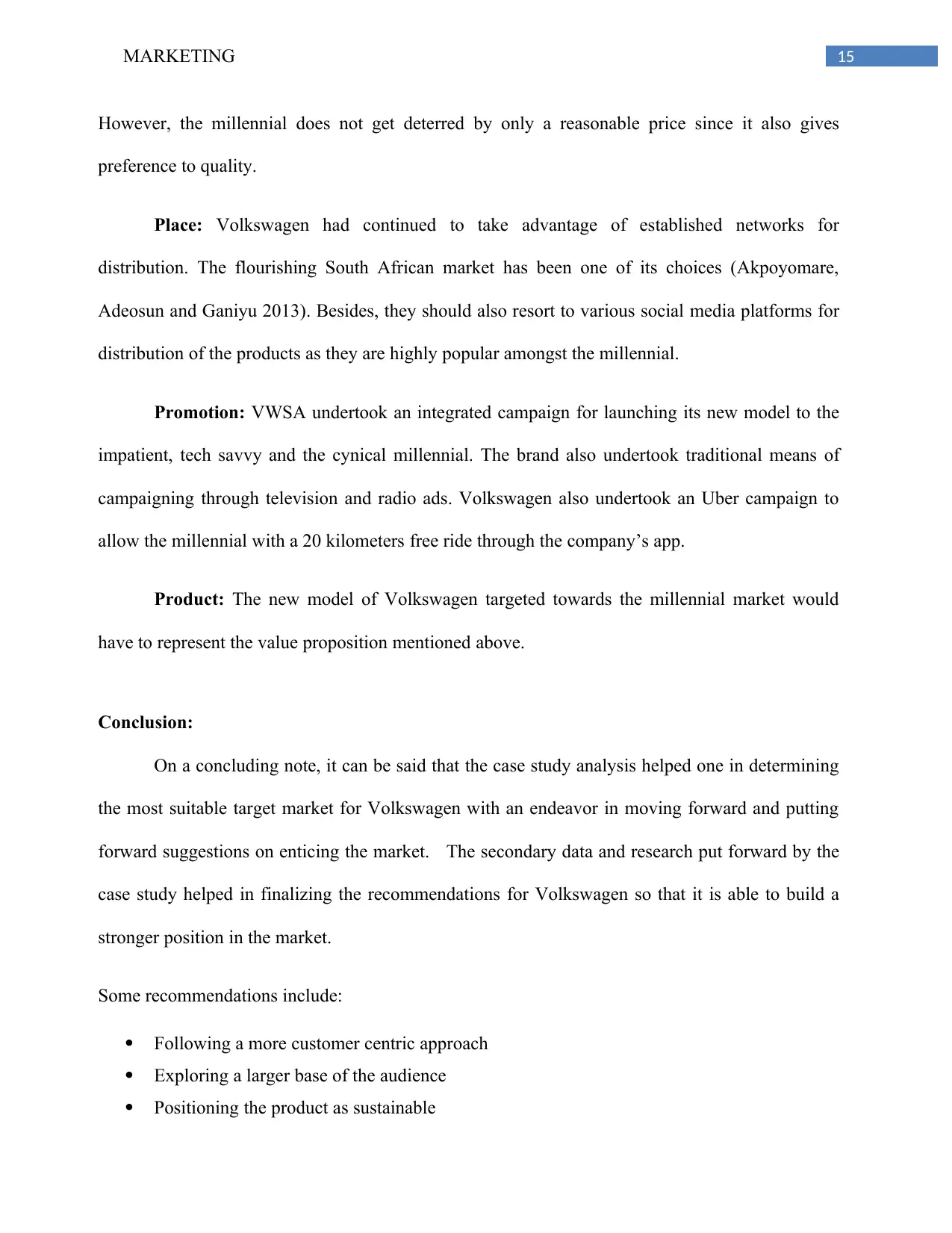
15MARKETING
However, the millennial does not get deterred by only a reasonable price since it also gives
preference to quality.
Place: Volkswagen had continued to take advantage of established networks for
distribution. The flourishing South African market has been one of its choices (Akpoyomare,
Adeosun and Ganiyu 2013). Besides, they should also resort to various social media platforms for
distribution of the products as they are highly popular amongst the millennial.
Promotion: VWSA undertook an integrated campaign for launching its new model to the
impatient, tech savvy and the cynical millennial. The brand also undertook traditional means of
campaigning through television and radio ads. Volkswagen also undertook an Uber campaign to
allow the millennial with a 20 kilometers free ride through the company’s app.
Product: The new model of Volkswagen targeted towards the millennial market would
have to represent the value proposition mentioned above.
Conclusion:
On a concluding note, it can be said that the case study analysis helped one in determining
the most suitable target market for Volkswagen with an endeavor in moving forward and putting
forward suggestions on enticing the market. The secondary data and research put forward by the
case study helped in finalizing the recommendations for Volkswagen so that it is able to build a
stronger position in the market.
Some recommendations include:
Following a more customer centric approach
Exploring a larger base of the audience
Positioning the product as sustainable
However, the millennial does not get deterred by only a reasonable price since it also gives
preference to quality.
Place: Volkswagen had continued to take advantage of established networks for
distribution. The flourishing South African market has been one of its choices (Akpoyomare,
Adeosun and Ganiyu 2013). Besides, they should also resort to various social media platforms for
distribution of the products as they are highly popular amongst the millennial.
Promotion: VWSA undertook an integrated campaign for launching its new model to the
impatient, tech savvy and the cynical millennial. The brand also undertook traditional means of
campaigning through television and radio ads. Volkswagen also undertook an Uber campaign to
allow the millennial with a 20 kilometers free ride through the company’s app.
Product: The new model of Volkswagen targeted towards the millennial market would
have to represent the value proposition mentioned above.
Conclusion:
On a concluding note, it can be said that the case study analysis helped one in determining
the most suitable target market for Volkswagen with an endeavor in moving forward and putting
forward suggestions on enticing the market. The secondary data and research put forward by the
case study helped in finalizing the recommendations for Volkswagen so that it is able to build a
stronger position in the market.
Some recommendations include:
Following a more customer centric approach
Exploring a larger base of the audience
Positioning the product as sustainable
Secure Best Marks with AI Grader
Need help grading? Try our AI Grader for instant feedback on your assignments.
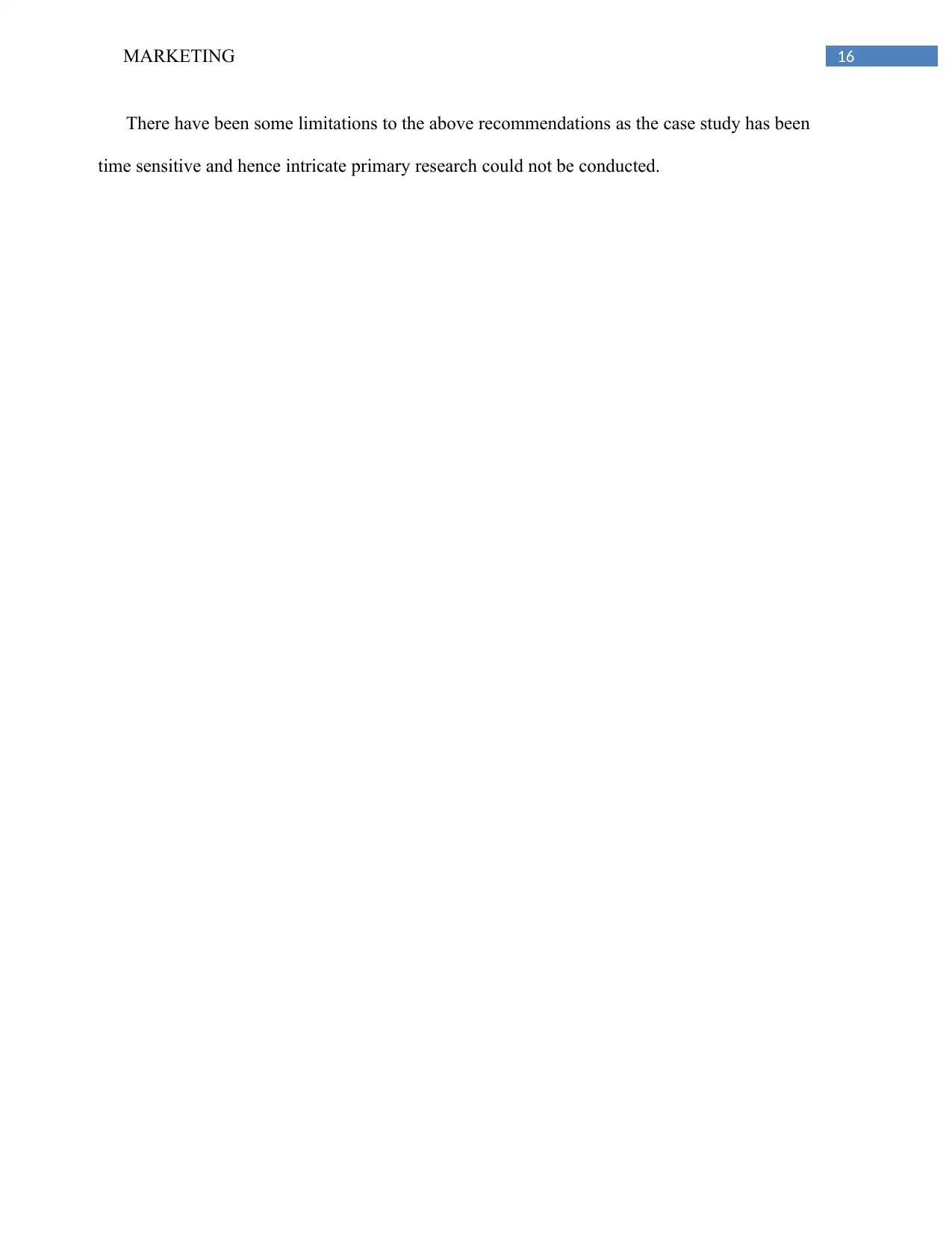
16MARKETING
There have been some limitations to the above recommendations as the case study has been
time sensitive and hence intricate primary research could not be conducted.
There have been some limitations to the above recommendations as the case study has been
time sensitive and hence intricate primary research could not be conducted.
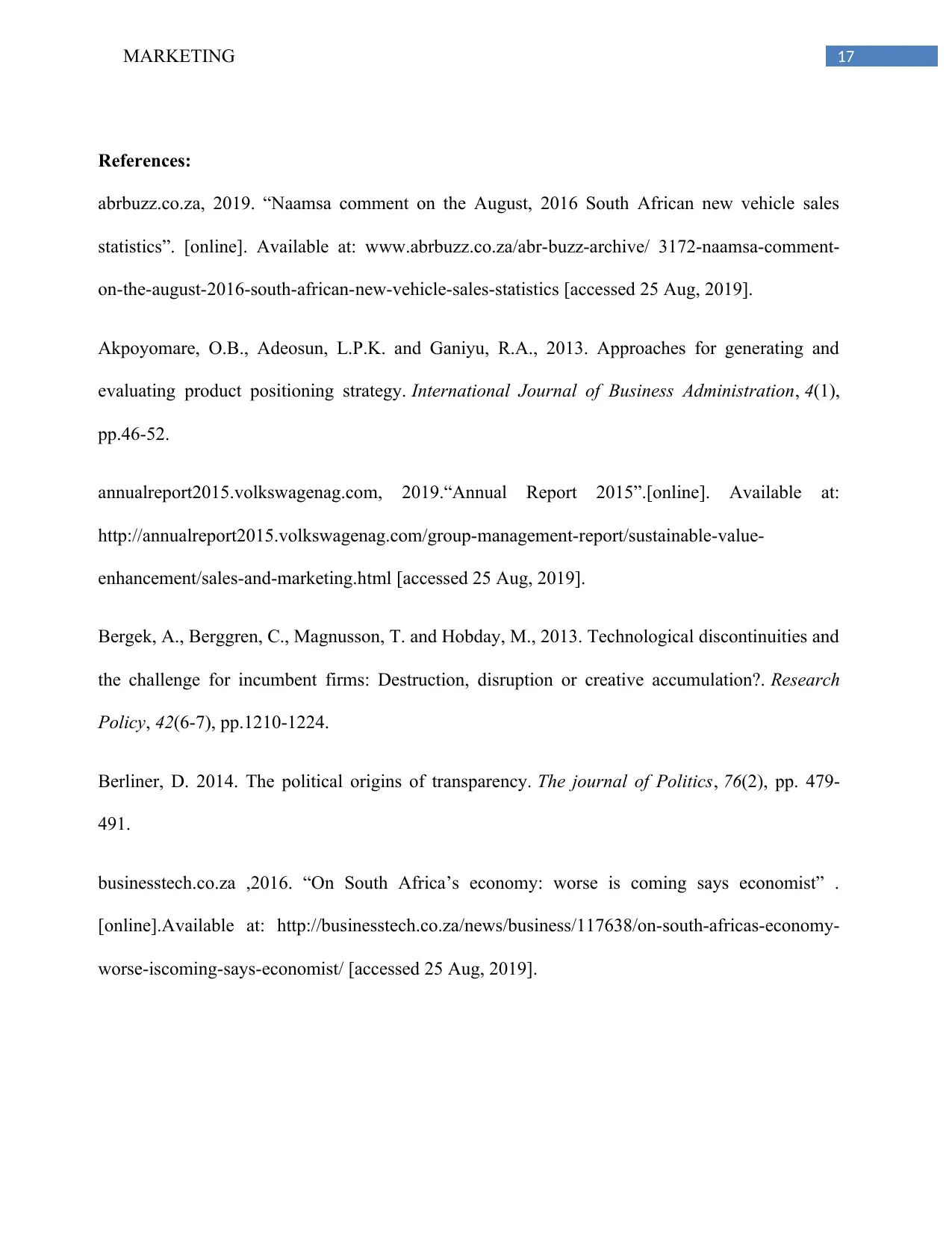
17MARKETING
References:
abrbuzz.co.za, 2019. “Naamsa comment on the August, 2016 South African new vehicle sales
statistics”. [online]. Available at: www.abrbuzz.co.za/abr-buzz-archive/ 3172-naamsa-comment-
on-the-august-2016-south-african-new-vehicle-sales-statistics [accessed 25 Aug, 2019].
Akpoyomare, O.B., Adeosun, L.P.K. and Ganiyu, R.A., 2013. Approaches for generating and
evaluating product positioning strategy. International Journal of Business Administration, 4(1),
pp.46-52.
annualreport2015.volkswagenag.com, 2019.“Annual Report 2015”.[online]. Available at:
http://annualreport2015.volkswagenag.com/group-management-report/sustainable-value-
enhancement/sales-and-marketing.html [accessed 25 Aug, 2019].
Bergek, A., Berggren, C., Magnusson, T. and Hobday, M., 2013. Technological discontinuities and
the challenge for incumbent firms: Destruction, disruption or creative accumulation?. Research
Policy, 42(6-7), pp.1210-1224.
Berliner, D. 2014. The political origins of transparency. The journal of Politics, 76(2), pp. 479-
491.
businesstech.co.za ,2016. “On South Africa’s economy: worse is coming says economist” .
[online].Available at: http://businesstech.co.za/news/business/117638/on-south-africas-economy-
worse-iscoming-says-economist/ [accessed 25 Aug, 2019].
References:
abrbuzz.co.za, 2019. “Naamsa comment on the August, 2016 South African new vehicle sales
statistics”. [online]. Available at: www.abrbuzz.co.za/abr-buzz-archive/ 3172-naamsa-comment-
on-the-august-2016-south-african-new-vehicle-sales-statistics [accessed 25 Aug, 2019].
Akpoyomare, O.B., Adeosun, L.P.K. and Ganiyu, R.A., 2013. Approaches for generating and
evaluating product positioning strategy. International Journal of Business Administration, 4(1),
pp.46-52.
annualreport2015.volkswagenag.com, 2019.“Annual Report 2015”.[online]. Available at:
http://annualreport2015.volkswagenag.com/group-management-report/sustainable-value-
enhancement/sales-and-marketing.html [accessed 25 Aug, 2019].
Bergek, A., Berggren, C., Magnusson, T. and Hobday, M., 2013. Technological discontinuities and
the challenge for incumbent firms: Destruction, disruption or creative accumulation?. Research
Policy, 42(6-7), pp.1210-1224.
Berliner, D. 2014. The political origins of transparency. The journal of Politics, 76(2), pp. 479-
491.
businesstech.co.za ,2016. “On South Africa’s economy: worse is coming says economist” .
[online].Available at: http://businesstech.co.za/news/business/117638/on-south-africas-economy-
worse-iscoming-says-economist/ [accessed 25 Aug, 2019].
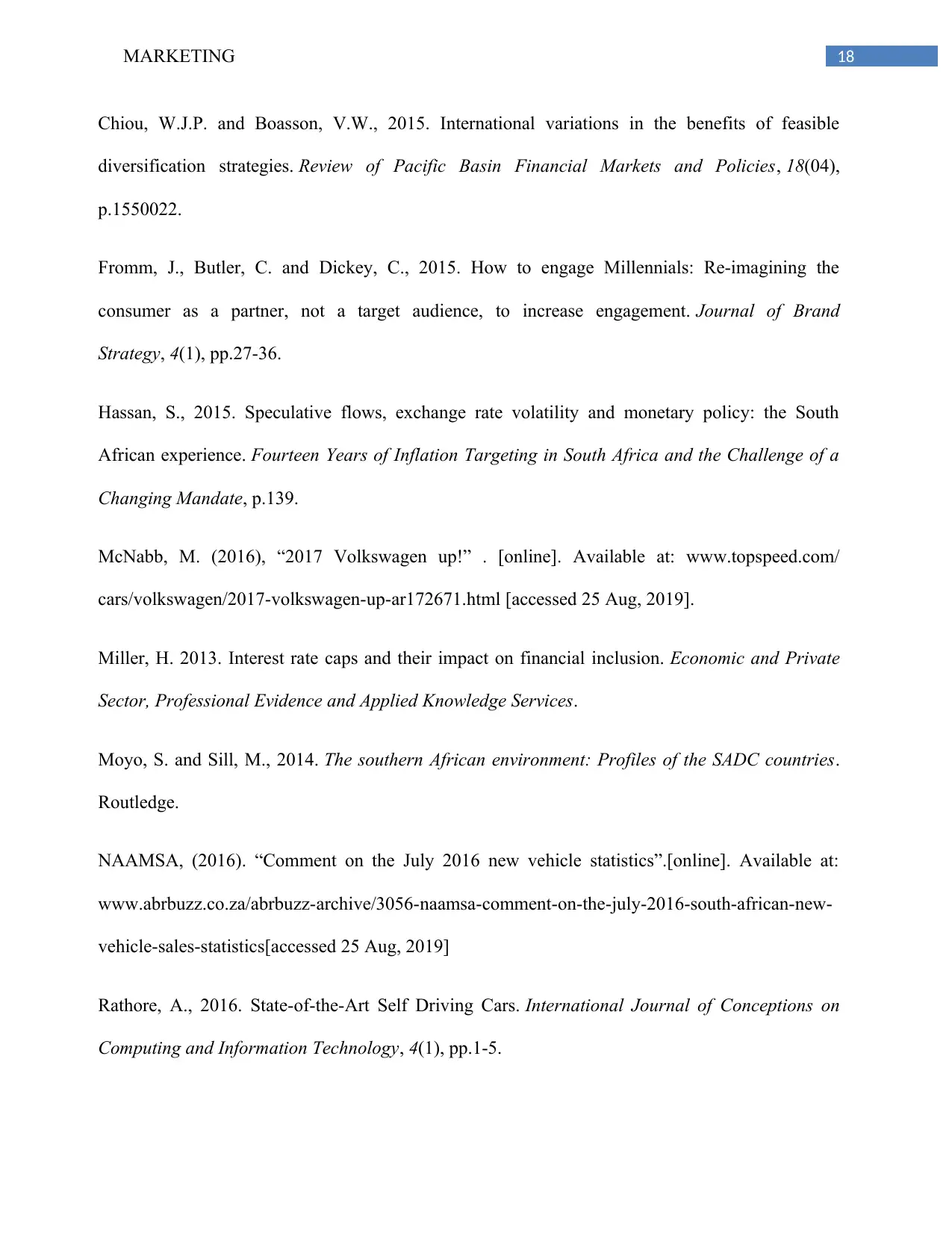
18MARKETING
Chiou, W.J.P. and Boasson, V.W., 2015. International variations in the benefits of feasible
diversification strategies. Review of Pacific Basin Financial Markets and Policies, 18(04),
p.1550022.
Fromm, J., Butler, C. and Dickey, C., 2015. How to engage Millennials: Re-imagining the
consumer as a partner, not a target audience, to increase engagement. Journal of Brand
Strategy, 4(1), pp.27-36.
Hassan, S., 2015. Speculative flows, exchange rate volatility and monetary policy: the South
African experience. Fourteen Years of Inflation Targeting in South Africa and the Challenge of a
Changing Mandate, p.139.
McNabb, M. (2016), “2017 Volkswagen up!” . [online]. Available at: www.topspeed.com/
cars/volkswagen/2017-volkswagen-up-ar172671.html [accessed 25 Aug, 2019].
Miller, H. 2013. Interest rate caps and their impact on financial inclusion. Economic and Private
Sector, Professional Evidence and Applied Knowledge Services.
Moyo, S. and Sill, M., 2014. The southern African environment: Profiles of the SADC countries.
Routledge.
NAAMSA, (2016). “Comment on the July 2016 new vehicle statistics”.[online]. Available at:
www.abrbuzz.co.za/abrbuzz-archive/3056-naamsa-comment-on-the-july-2016-south-african-new-
vehicle-sales-statistics[accessed 25 Aug, 2019]
Rathore, A., 2016. State-of-the-Art Self Driving Cars. International Journal of Conceptions on
Computing and Information Technology, 4(1), pp.1-5.
Chiou, W.J.P. and Boasson, V.W., 2015. International variations in the benefits of feasible
diversification strategies. Review of Pacific Basin Financial Markets and Policies, 18(04),
p.1550022.
Fromm, J., Butler, C. and Dickey, C., 2015. How to engage Millennials: Re-imagining the
consumer as a partner, not a target audience, to increase engagement. Journal of Brand
Strategy, 4(1), pp.27-36.
Hassan, S., 2015. Speculative flows, exchange rate volatility and monetary policy: the South
African experience. Fourteen Years of Inflation Targeting in South Africa and the Challenge of a
Changing Mandate, p.139.
McNabb, M. (2016), “2017 Volkswagen up!” . [online]. Available at: www.topspeed.com/
cars/volkswagen/2017-volkswagen-up-ar172671.html [accessed 25 Aug, 2019].
Miller, H. 2013. Interest rate caps and their impact on financial inclusion. Economic and Private
Sector, Professional Evidence and Applied Knowledge Services.
Moyo, S. and Sill, M., 2014. The southern African environment: Profiles of the SADC countries.
Routledge.
NAAMSA, (2016). “Comment on the July 2016 new vehicle statistics”.[online]. Available at:
www.abrbuzz.co.za/abrbuzz-archive/3056-naamsa-comment-on-the-july-2016-south-african-new-
vehicle-sales-statistics[accessed 25 Aug, 2019]
Rathore, A., 2016. State-of-the-Art Self Driving Cars. International Journal of Conceptions on
Computing and Information Technology, 4(1), pp.1-5.
Paraphrase This Document
Need a fresh take? Get an instant paraphrase of this document with our AI Paraphraser
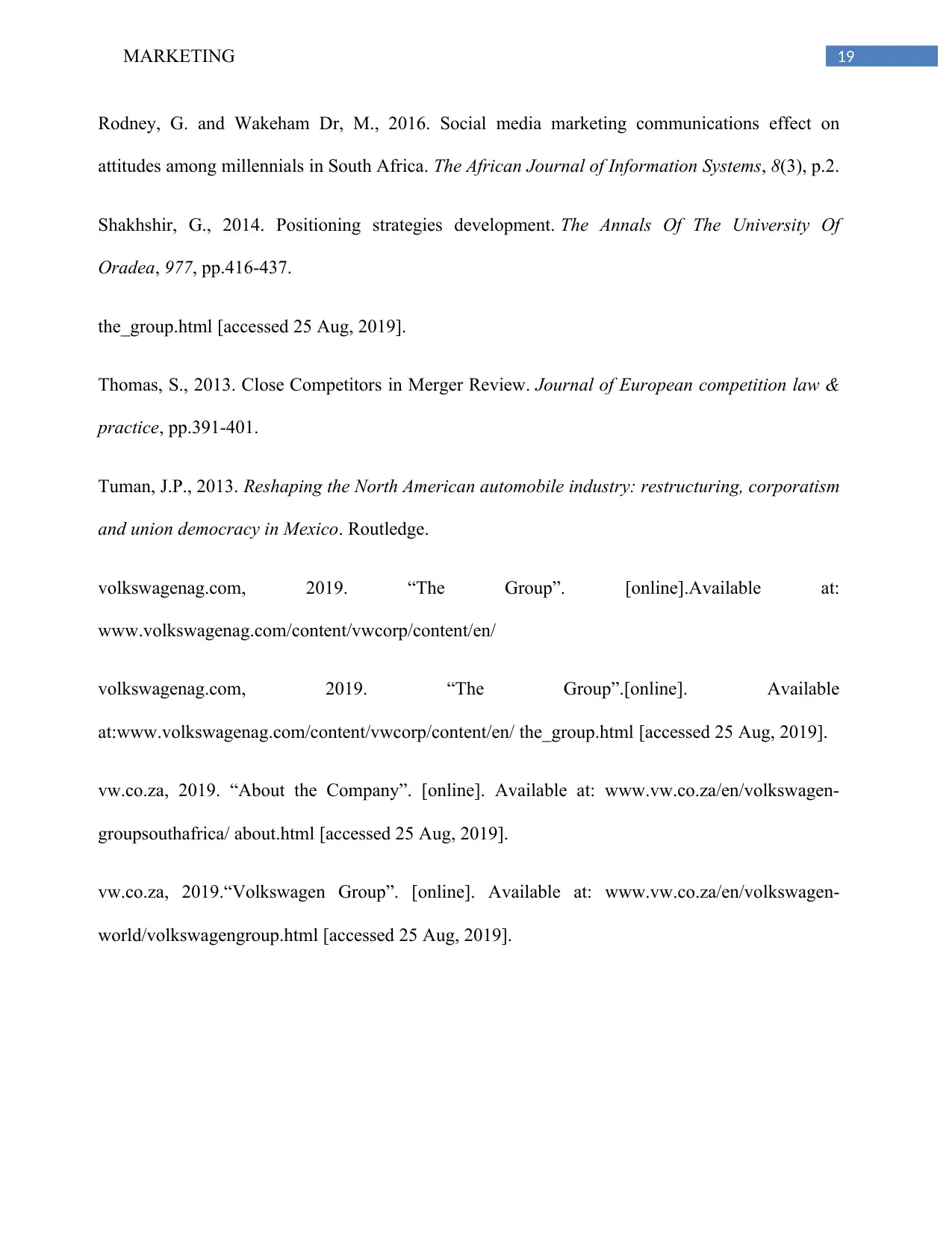
19MARKETING
Rodney, G. and Wakeham Dr, M., 2016. Social media marketing communications effect on
attitudes among millennials in South Africa. The African Journal of Information Systems, 8(3), p.2.
Shakhshir, G., 2014. Positioning strategies development. The Annals Of The University Of
Oradea, 977, pp.416-437.
the_group.html [accessed 25 Aug, 2019].
Thomas, S., 2013. Close Competitors in Merger Review. Journal of European competition law &
practice, pp.391-401.
Tuman, J.P., 2013. Reshaping the North American automobile industry: restructuring, corporatism
and union democracy in Mexico. Routledge.
volkswagenag.com, 2019. “The Group”. [online].Available at:
www.volkswagenag.com/content/vwcorp/content/en/
volkswagenag.com, 2019. “The Group”.[online]. Available
at:www.volkswagenag.com/content/vwcorp/content/en/ the_group.html [accessed 25 Aug, 2019].
vw.co.za, 2019. “About the Company”. [online]. Available at: www.vw.co.za/en/volkswagen-
groupsouthafrica/ about.html [accessed 25 Aug, 2019].
vw.co.za, 2019.“Volkswagen Group”. [online]. Available at: www.vw.co.za/en/volkswagen-
world/volkswagengroup.html [accessed 25 Aug, 2019].
Rodney, G. and Wakeham Dr, M., 2016. Social media marketing communications effect on
attitudes among millennials in South Africa. The African Journal of Information Systems, 8(3), p.2.
Shakhshir, G., 2014. Positioning strategies development. The Annals Of The University Of
Oradea, 977, pp.416-437.
the_group.html [accessed 25 Aug, 2019].
Thomas, S., 2013. Close Competitors in Merger Review. Journal of European competition law &
practice, pp.391-401.
Tuman, J.P., 2013. Reshaping the North American automobile industry: restructuring, corporatism
and union democracy in Mexico. Routledge.
volkswagenag.com, 2019. “The Group”. [online].Available at:
www.volkswagenag.com/content/vwcorp/content/en/
volkswagenag.com, 2019. “The Group”.[online]. Available
at:www.volkswagenag.com/content/vwcorp/content/en/ the_group.html [accessed 25 Aug, 2019].
vw.co.za, 2019. “About the Company”. [online]. Available at: www.vw.co.za/en/volkswagen-
groupsouthafrica/ about.html [accessed 25 Aug, 2019].
vw.co.za, 2019.“Volkswagen Group”. [online]. Available at: www.vw.co.za/en/volkswagen-
world/volkswagengroup.html [accessed 25 Aug, 2019].
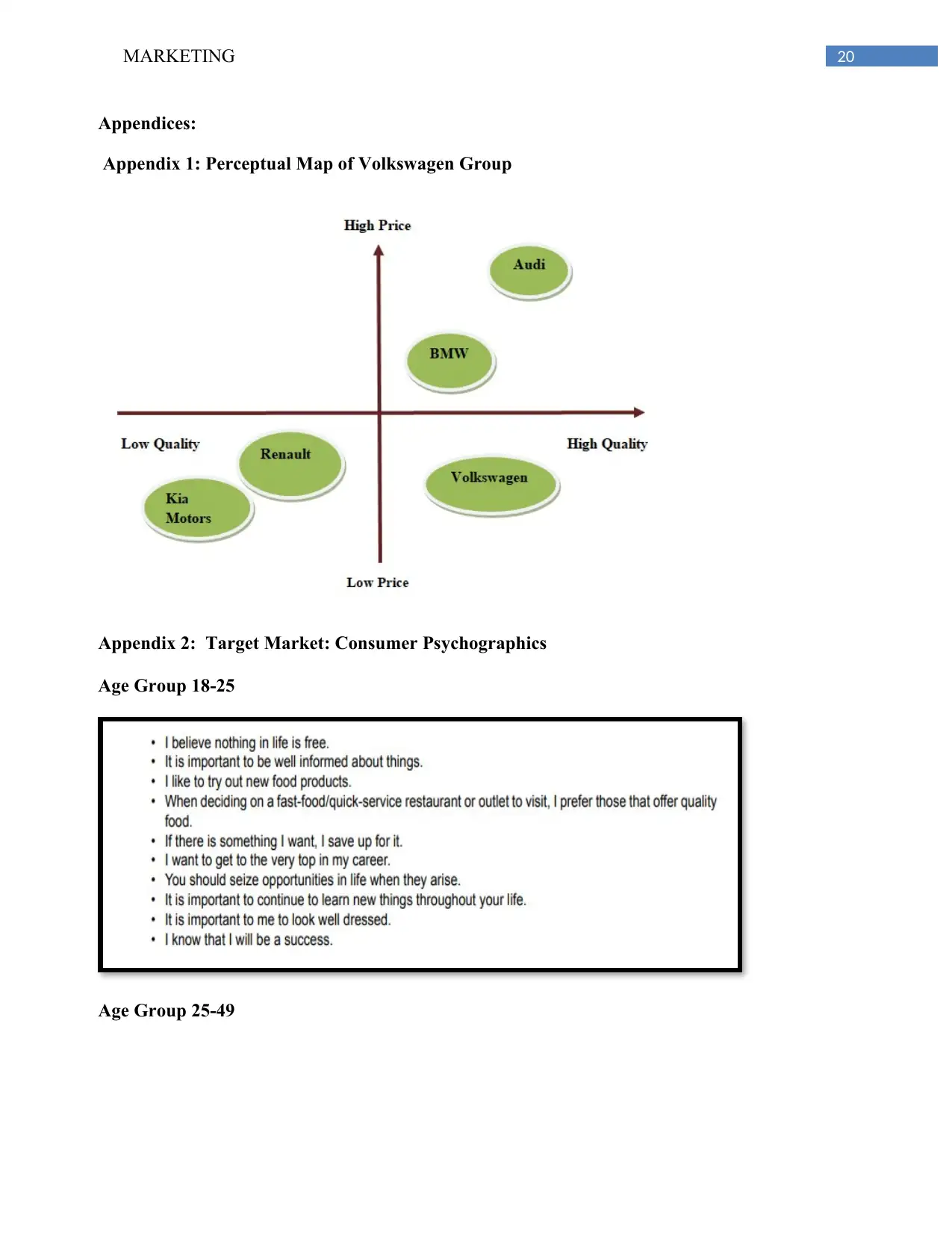
20MARKETING
Appendices:
Appendix 1: Perceptual Map of Volkswagen Group
Appendix 2: Target Market: Consumer Psychographics
Age Group 18-25
Age Group 25-49
Appendices:
Appendix 1: Perceptual Map of Volkswagen Group
Appendix 2: Target Market: Consumer Psychographics
Age Group 18-25
Age Group 25-49
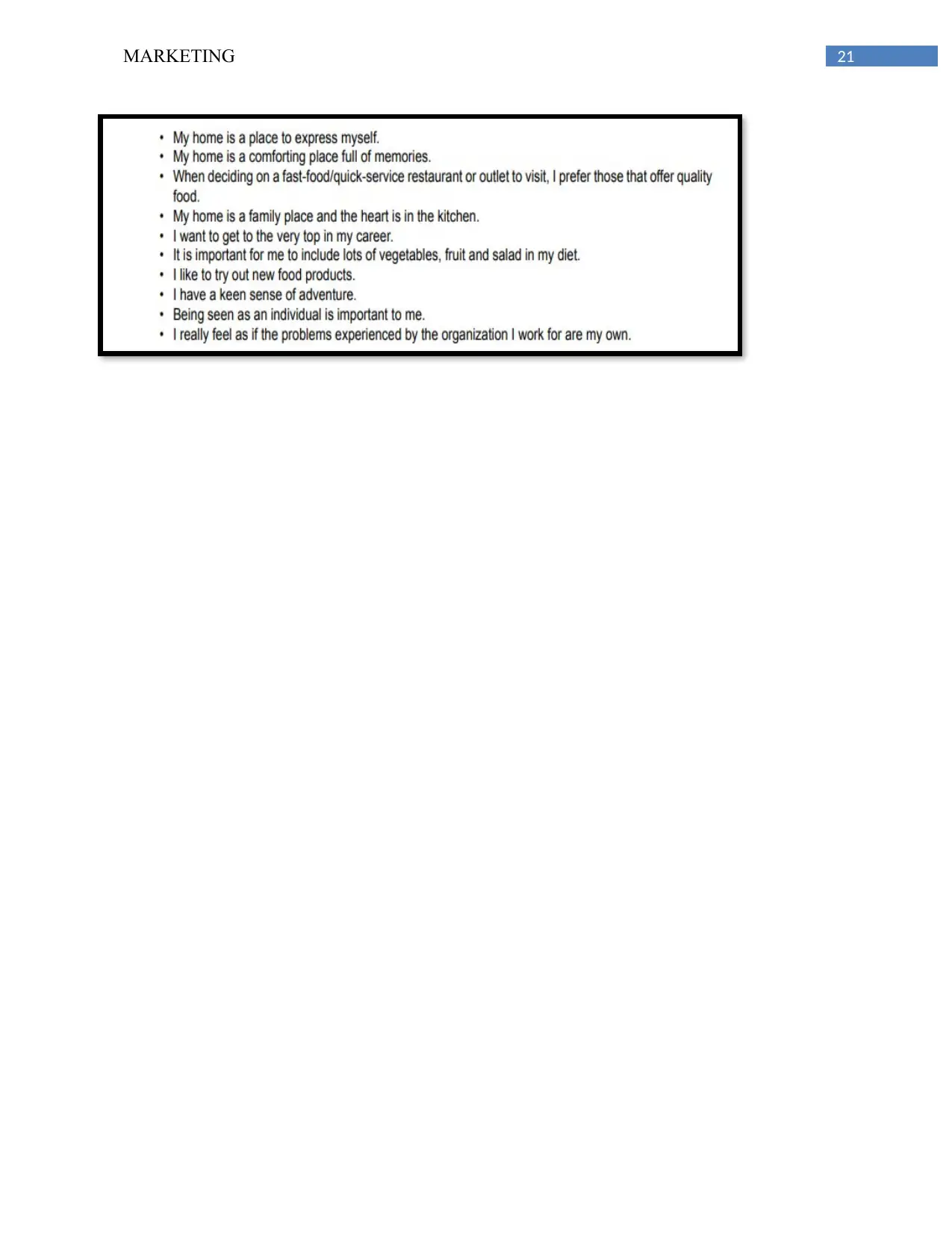
21MARKETING
Secure Best Marks with AI Grader
Need help grading? Try our AI Grader for instant feedback on your assignments.
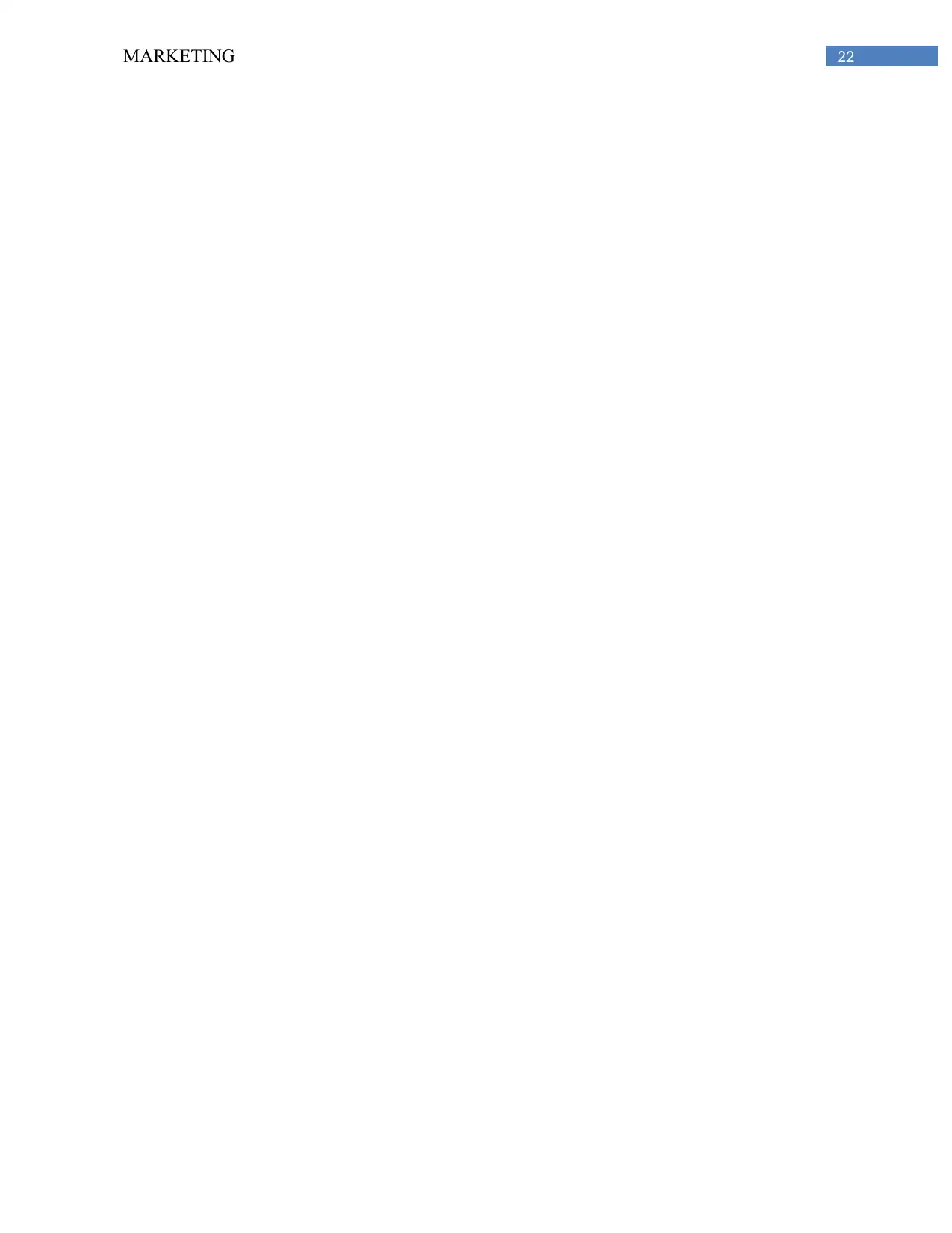
22MARKETING
1 out of 23
Related Documents
Your All-in-One AI-Powered Toolkit for Academic Success.
+13062052269
info@desklib.com
Available 24*7 on WhatsApp / Email
![[object Object]](/_next/static/media/star-bottom.7253800d.svg)
Unlock your academic potential
© 2024 | Zucol Services PVT LTD | All rights reserved.





